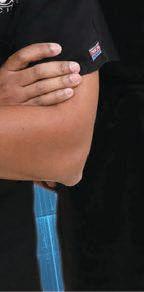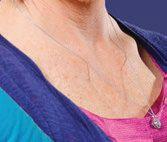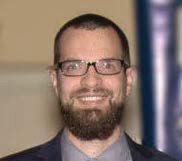






















































Ask him how we replaced his aortic valve.










Transcatheter Aortic Valve Replacement (TAVR) is a technical way of saying incredibly advanced, minimally invasive valve replacement. And it’s just one example of how we’re turning patients into trendsetters. Learn more about our advanced heart and vascular team at LeesburgRegional.org.
 —ADIL A. MOHAMMED, M.D.
—ADIL A. MOHAMMED, M.D.






















Are stem cells a miracle? Not exactly. However, stem cells are a highly effective means of repairing damaged tissue. Stem cell therapy is a non-surgical procedure that gives the body the tools it needs to heal itself naturally. Stem cells repair damaged tissue and regenerate bone, ligaments, tendons, cartilage and muscle. Pain lessens and range of motion increases after a simple injection—without risk of infection.








Schedule a consult today to see if you are eligible for this cutting edge therapy.
John T. Williams Jr. Orthopedic Surgeon














The nation’s largest dermatology practice has three locations in The Villages ® community. We now accept UnitedHealthcare Medicare Advantage.
1503 Buenos Aires Blvd., Bldg. 100


The Villages, FL 32162
352.753.2812
Dr. Michael Bond (Retiring January 2018)
Dr. Michael Wangia
Dr. Christine Moorhead
Scott Clark, PA-C
Nicole Hwa, PA-C
Dori Hite, PA-C (Coming Soon)
Kimberly Neumann, Licensed Aesthetician
Lake Sumter Landing™
910 Old Camp Road Suite 166
The Villages, FL 32162
352.205.4959
Dr. Michael Bond (Retiring January 2018)
Dr. Michael Burton
Al Sy, PA-C
Kimberly Neumann, Licensed Aesthetician
Appointments: 866.400.DERM (3376)



























After graduating with Honors from Howard University College of Medicine, Dr. Wangia attended University of Florida where he completed his dermatology residency serving as a chief resident. He also completed his dermatopathology fellowship training at UF where he served as an Assistant Professor of Dermatology. He was awarded “The Arnold P. Gold Humanism in Medicine Award”. Today, he is committed to providing compassionate, comprehensive and individualized dermatologic therapies.
Following a storied career, marked by excellence in patient care, Dr. Bond is retiring. Please join us in wishing him well.




Enjoy a simple meatball recipe that’s healthy and tasty.
Food for thought. Learn the difference between food allergies, food intolerance, and food sensitivity. Break the mold. Humans are exposed to mold, fungi, and yeast at increasingly alarming rates.



stress. It’s never much fun to feel overwhelmed, anxious, and completely frazzled. Everyone experiences stress at one time or another, and it hits for different reasons. There may be worry about paying bills or thriving in a high-pressured job. Fortunately, there are many effective ways to cope with stress, as HealthyLiving learned
Story: James Combs
28.
Much is unknown about irritable bowel syndrome—its cause and cure, for starters—but treatment can make IBS managable.
Story: Chris Gerbasi
PAID PROMOTIONAL FEATURE

Receive valuable advice from experts who
62. Something to keep in mind. The differences between Alzheimer’s disease and dementia.
64. Net gains. The internet and social media provide support for those suffering in silence.
69.


70. Stay cool, calm, and collected. Tips to minimize stress.


72. Forgive and forget. Forgiveness provides hope for a healing heart.



75.
76. Making sense of cents. from Dave Ramsey.


78. Please remove your card! High tech is changing the banking world.
COLUMNS
10. Publisher’s letter
11. At Your Service
12. Health matters



14. Healthy inspiration
16. Medical mysteries



ON THE COVER and John T. Williams Jr.
90. Final impressions
Being a small-business owner, mother of six children, one of which is a toddler, and having had three nervous breakdowns over the past 10 years, I know all too well what stress can do to the body.
When we first started our business, the competition was extremely tough, and the market had just taken a dive into the great economic recession. My husband Doug and I worked extremely long hours and devoted every waking moment together talking and strategizing about our business. On top of that, we had three preteen daughters who were on a mission to destroy each other’s lives, which led to an enormous amount of drama within our household. Needless to say, I was dealing with a great deal of stress and doing my very best to hold it all together.
After several years of hard work within my personal life and my business, things began to improve, and it wasn’t until life had calmed down that I began to see the aftermath of what the constant stress had done to my body. I began to experience vertigo randomly at work, at home, and for no apparent reason. Then the panic attacks started and continued to the point of a full-blown nervous breakdown, which led to me taking a week off work and not leaving my bedroom, so I could regain my senses and slowly return to a normal life.
Ultimately, the doctors said I had experienced the breakdown due to an extreme amount of long-term stress and physical exhaustion. It was my body’s way of telling me to slow down. Over the next several years, I had two more episodes, neither of which were as bad as the first.
These days, I still endure stress and have a very demanding personal and professional life. But I have learned to recognize the signs and the symptoms of stress overload, and now I have a solution. I have learned to take one day at a time, focus on the positive aspects of life, and not sweat the small stuff, or the big stuff for that matter. I now know that I will give every ounce of effort to everything I do because that is just who I am, but I also know if that still is not enough, then I will change course and find another way. I have a sense of peace about me now and the knowledge that I am a survivor. I can handle all that life has to offer as long as I take it slow and steady, one step at a time.
If you struggle with dealing with stress, I leave you with this amazing quote that I learned to live by: “Life is 10 percent what happens to you, and 90 percent how you react to it.”
—Charles R. Swindoll.Doug Akers / President doug@akersmediagroup.com
Kendra Akers kendra@akersmediagroup.com
Jamie Ezra Mark jamie@akersmediagroup.com
editorial, design & photography
Leigh Neely Managing Editor leigh@akersmediagroup.com

James Combs Staff Writer james@akersmediagroup.com
Theresa Campbell Staff Writer theresa@akersmediagroup.com
Chris Gerbasi Staff Writer chris@akersmediagroup.com
Jason Fugate jason@akersmediagroup.com
Volkan Ulgen Art Director volkan@akersmediagroup.com
Josh Clark Senior Designer josh@akersmediagroup.com
Michael Gaulin Production Director michael@akersmediagroup.com
Fred Lopez fred@akersmediagroup.com
contributing writers


Fred Hilton, Richard T. Bosshardt M.D., Dave Ramsey, Jamie Alonso,
sales & marketing
Tim McRae Vice President, Sales & Marketing tim@akersmediagroup.com
William Carter Advertising Executive william@akersmediagroup.com
Jacquelyn Singer Advertising Executive jacquelyn@akersmediagroup.com
Shaena Chastain Sales Assistant shaena@akersmediagroup.com
administration
Deb Matlock deb@akersmediagroup.com Aubrey Akers aubrey@akersmediagroup.com
distribution
Scott Hegg / Distribution Manager scott.hegg@akersmediagroup.com

digital social media
Garrett Reardon / Digital Specialist garrett@akersmediagroup.com
goal is to provide you with the best quality publication, so your feedback is vital.
Healthy Living Healthy Living Magazine. All reproduction or use of content without written permission is strictly Healthy Living Magazine are for informational purposes only. The information is not intended to be an alternative to professional medical advice, diagnosis or treatment. Always seek the advice program. The ideas and opinions contained in this publication do not necessarily reflect the thoughts or opinions of Akers Media.
The
Subscriptions:

Change of address: If you are a seasonal resident or have moved, send your address change request to general@akersmediagroup.com or mail us at: Subscriptions at
Back issues:
Avon has long been known for its skin care and beauty products, but now the company is taking skin care and health a step further with Espira, a complete line of supplements that focuses on supporting natural energy and meeting lifestyle needs. The three core wellness goals include boosting natural energy, giving your skin the glow it needs from the inside out, and helping restore the natural balance of the body by filling the nutritional gaps, reducing occasional stress, and aiding with restful sleep. Like all Avon products, these supplements are of the highest quality, have non-GMO ingredients, no preservatives, no artificial flavors or colors, and were created by leading industry experts. At avon.com/category/health-wellness, you can take a quiz to gauge what supplements your body needs. Healthy Living was provided samples of all these products and found them to be effective in providing tangible improvements. As always, talk to your doctor about any vitamins or supplements you’re adding to your diet.

According to the recent “State of Tobacco Control” released by the American Lung Association (ALA), Florida made poor grades when it came to implementing tobacco policies. “Nationwide, smoking rates have continued to decline to historically low levels, yet tobacco use remains the nation’s leading cause of preventable death and disease killing over 480,000 Americans each year,” says American Lung Association Executive Vice President Martha Bogdan. “Tobacco use is a serious addiction, and the fact that 15.5 percent of Florida residents are current smokers highlights how much work remains to be done in our communities to prevent and reduce tobacco use.” The state report card doesn’t look good:
• Funding for state tobacco prevention programs



– Grade F

• Strength of smoke-free workplace laws - Grade B
• Level of state tobacco taxes - Grade F
• tobacco - Grade D
• Minimum age of sale for tobacco products
Numerous studies show that seven of 10 smokers want to quit but cannot let go of their serious addiction. However, more were able to quit smoking when coverage for tobacco treatments included access to all seven FDA-approved medications to help smokers quit and counseling without copays and prior authorization. The National Academy of Medicine found making 21 the minimum age for purchasing tobacco products could also prevent a significant number of deaths.
‘‘
Nationwide, smoking rates have continued to decline to historically low levels, yet tobacco use remains the nation’s leading cause of preventable death and disease killing over 480,000 Americans each year,
—Martha Bogdan, American Lung Association executive vice president
Keeping your heart healthy can affect how well your recovery goes with chronic wounds. These wounds affect about 6.7 million in the United States every year, and if treatment is not received, it could mean amputation. Many amputations are due to complications related to vascular disease, according to a recent press release from The Villages Regional Hospital (TVRH). “Coronary artery disease, peripheral arterial disease, and other issues with the heart and vessels can hinder blood flow, oxygen, and nutrition to a wound,” explains Dr. Panthipa Laowansiri, medical director for the Wound Care & Hyperbaric Center in The Villages.
TVRH recommends the following tips to live a heart-healthy life:




• exercise most days.

• Don’t smoke or use tobacco products because they increase your risk for heart disease.


• Eat lots of fruits, vegetables, whole grains, beans, and other low-fat proteins.

• Keep your weight at a healthy level. Get plenty of sleep; make it priority to get at least seven to nine hours of rest every night.
• Manage stress in a healthy way: give yourself pep talks, use stress stoppers, do things you enjoy so you relax completely, and do them often.
• See your doctor regularly.

If you’d like to know more about heart health and how it affects wound healing, contact TVRH Wound Care & Hyperbaric Center at 352.751.8830.
Florida Hospital Waterman has a blog on its website fl can get information on the proper way to work out, get questions answered about radiation treatment, and answers to simpler questions such as, “What’s the difference between a CT scan and an MRI?” These informational blogs are posted regularly and may answer many of your health-related questions and ease the anxiety surrounding a health issue you’re facing. The blog page is called, “State of Health.” Check it out at the website above.





Therapy, family, and friends help Becca Laws cope with Vegas shooting trauma.

Story:
Becca Laws remembers a white purse on the ground with lip gloss and a wallet spilling out. Nearby, a wheelchair with an oxygen tank on the back was empty. Shoes slipped from the feet of panicked eld. One boot was left behind. These small snapshots are just as indelible for Becca as the big picture of a horrific Sunday night in Las Vegas: The smell rst-aid tent that looked like a MASH unit.
Becca, of Weirsdale, and friend Shelley Mallory, of Belleview, were enjoying a country music festival Oct. 1, 2017, when a re on a crowd of 22,000 people. Shooter Stephen Paddock killed 58 people and wounded more than 400 others before killing himself,
It’s the deadliest mass shooting in U.S. history, and six nds it unbelievable that she was


“When it started, I was laying there going, ‘This isn’t happening. This isn’t real,’” she says. “It was a war zone. I literally




For 10 minutes, Becca and Shelley zigzagged across eld—the “kill box,” as some called it—hitting the re and running in
“There were people hysterical on the ground, crying, (they) couldn’t move…paralyzed, hyperventilating, freaking out. I
Eventually, they reached a parking lot and found an off-duty cer who drove them through the chaotic streets of the Vegas Strip to the police department. Adrenaline and fear kept them
cult for Becca, who has two teenage daughters, Katelynn and Liv, and works part time in The Villages. The family lives on land where people shooting target practice is common, and Becca is a gun owner who has shot her whole life. But one day the sound of rapid-fi gunshots from a nearby property made her instinctively jump out of bed and get down on the floor.
rst time she went out by herself at night, and she looks at people more warily. Other mass shootings, like the one in February at the Parkland high school,
Through therapy and talking about the shooting, both she and Shelley are feeling better each day, Becca says. She’s found
“Therapy helps everybody, I think,” Becca says. “It really makes a difference. I think talking about it when you’re
Far from blocking out the trauma, Becca watched everything nd about the Vegas shooting, even searching for the shooter’s death photos so she could see for herself
“If I would’ve had the chance to kill him myself, I would have,”
The shooting hasn’t changed her views on gun laws.
“People are going to get guns illegally no matter what,” Becca says. “Why take rights away from people that do the proper steps and have background checks to protect themselves? Nothing could’ve changed this situation. He was a sick man and he was going to do what he intended to do. I think maybe they should look into helping people with mental health problems.”
But the shooting has changed her view of the world around her.
“I’m thankful I get to see my kids grow up,” Becca says. “It does change the way you feel. You appreciate little things. You appreciate being able to go to your kids’ track meets, going to see their dance performances. You might not have been able to do that anymore.”
However, the music fan and avid concert-goer has not attended any big events since Vegas.
“I say that often to my husband: ‘I hope I get to the point where I can go to another concert,’” Becca says. “That’s a









Man’s best friend also is good for man’s health.
 Story: Fred Hilton
Story: Fred Hilton
“Dogs’ lives are too short. Their only fault, really.”—Agnes Sligh Turnbull
If you’ve ever shared your life with a dog, you know that statement is true. Dogs give us absolute love. No matter how crummy your day has been, your dog will meet you at the door with enthusiasm and a wagging tail.
Author Jonathan Carroll says dogs are “minor angels,” because “they love unconditionally, forgive immediately, are the truest of friends, willing to do anything that makes us happy.” All they ask is a little food, some outdoor time, and an occasional tummy rub.
Dogs don’t just bring us love and happiness. Scientific studies have shown that dog owners live longer. The leading study was done by researchers at Sweden’s Uppsala University. The study focused on 3.4 million people, ages 40 to 80, who had no history of cardiovascular disease.
Reporting on the study, Time magazine states: “They found that dog owners had a lower risk of death due to cardiovascular disease than people who did not report owning a dog, as well as a lower risk of death from other causes. That was true even after adjusting for factors such as smoking, body mass index, and socioeconomic status.”
Other researchers agreed with the Swedish team. A panel of experts from the American Heart Association concluded that having a dog likely lowers the risk of heart disease. “The emotional benefits of having an affectionate creature are also one of the theories for why dog lovers live longer,” suggests Dr. Thomas Lee, co-editor in chief of the Harvard Heart Letter.
In addition to the emotional benefits, the presence of a dog probably causes its human friend to be move physically active and live a healthier lifestyle. “People who have dogs live longer than people who have cats, and the assumption has been that dogs naturally cause their owners to be more active,” the doctor says.
Dr. Tove Fall, the senior author of the Swedish study, says that people who choose to own dogs may simply be more active and in better health to begin with. She is a veterinarian and associate professor of epidemiology at Uppsala University. Many pet owners are convinced that their pet has been important to them in terms of social support. “I also notice that the people I meet during walks are often other dog owners, especially in bad weather,” she says.
But, the doctor says, not everyone is up to owning a dog: “Don’t give a dog to your grandmother in the hope she’ll live longer.”
Sources
“Dog Owners Live Longer,” by Nicholas Bakalar, New York Times, Nov. 22, 2017. nytimes.com/2017/11/22/well/family/dog-owners-live-longer.html
“A dog could be your heart’s best friend,” by Daniel DeNoon, executive editor, Harvard Heart Letter, Harvard Health Publishing, Harvard Medical School, Oct. 29, 2015. health.harvard.edu/blog/a-dog-could-be-your-hearts-best-friend-201305226291


“Do dog owners live longer?” by Nicky Broyd, WebMD UK Health Needs, Nov. 17, 2017. webmd.boots.com/heart-disease/news/20171117/do-dog-owners-live-longer 2017.


























Captain Chesley “Sully”
Sullenberger was an experienced aviator: a former Air Force F-4 ‘Phantom’ pilot who wrestled military aircraft when engine “flame-outs” happened. Years of training prepared this hero to exhibit unnerving skill when the ultimate situation demanded. With his team of co-pilot and crew, Sully ensured that every passenger would walk (not swim) away from death’s door.

Certainly the aircraft on that day was well designed and maintained. But that “bird” did not make the difference: rather, it was the combined knowledge of those professionals strapped within that fuselage. Radiation cancer care truly differs from the portrayal of a treatment machine somehow transformed into a life-saving “craft” whose performance and price tag cause spell-bound viewers to expect

something magical to happen: it won’t!



Put decisions for care where they count. Let’s compare “flight crews” and experience. The Robert Boissoneault Oncology Institute (RBOI) has four Villages radiation oncologists whose total expertise approaches 150 years, a nurse practitioner with almost 20 years, three PhD physicists where local competition has none, and 12 physics staff

personnel. RBOI continues to hold American College of Radiology accreditation, the most respected recognition awarded a comprehensive cancer center. Since Moffitt’s departure, we are the only radiation facility on The Villages campus with such accreditation—an honor we have attained for 22 years. This is your life. Sound medical decisions are only found when you interact with physicians.
With that in mind, bring this article to our office, and be scheduled to meet with one of our physicians for a second opinion...without cost.






















n today’s fast-paced, hectic world, we all have one companion. Stress.




It may lie dormant for short periods but is easily triggered by life events such as money problems, demanding jobs, failing relationships, and loss of family members or friends.
No matter how healthy or positive you are, everybody will feel that tense, grating, gripping feeling at one time or another.
If only we could turn off stress like a light switch.

While it’s an unavoidable part of life, stress can be successfully managed and minimized. In honor of Stress Awareness Month, Healthy Living interviewed five locals and asked what they do to keep cool when life becomes challenging.
 Story: James Combs Photos: Fred Lopez
Story: James Combs Photos: Fred Lopez

Owning a small business is akin to riding a roller coaster. There are lots of highs and lows, and sometimes you may feel queasy.
Timothy Totten has taken that ride many times. He is owner of Final Embrace, a Eustis-based company that makes blankets, quilts, and casket covers for funeral homes on five continents.



For him, stress comes from the fear of knowing his success or failure will directly affect the lives of his 15 employees who work hard to help him meet his everyday business goals.


“I’m always thinking of new ways to diversify my business because I want to make sure my employees can continue to eat,” he says.
It’s how he deals with stress that counts.

For Tim, channeling his creative side has proven to be the ultimate stress-buster. In recent years, he formed the game company Fun Ventures LLC, which allows him to create innovative and fun-filled game experiences for adults.


Those games have included Clue! Live Mystery Party at the Mote-Morris House in Leesburg, Pop Up Art Golf in downtown Mount Dora, and the Escape Game in a Box, a great team-building exercise for companies.

“Coming up with unique ideas for adult games feeds me personally,” he says. “Seeing other adults laughing, smiling, and having a good time is very fulfilling.”

Tim also is founder of the Amazing Race for Charity, which is modeled after the CBS hit reality show “Amazing Race.”


During the race, teams of two compete in quirky challenges that test their agility and problem-solving skills. The event, which will be held April 7, has raised $400,000 for local charities and nonprofit organizations since debuting in 2013.
“Doing good things for other people is a great way to improve your mood and reduce stress,” he says. “I want to live in a better place. I can rely on others to make it better or I can make it better myself. Also, I’m the type who gets easily bored, so I enjoy coming up with games and events to keep others from getting bored.”

When he’s not organizing games, Tim serves as a master storyteller who travels to different venues and takes audiences on a journey through the life of famous architect Frank Lloyd Wright. “His life story has love, adultery, murder, and the emperor of Japan, and that’s all in his first 45 years,” he says. “I have always been a big fan of Wright and am very passionate to talk about him. Doing things I’m passionate about helps minimize any stress I may be feeling.”

Give Melonie Henderson a Supermom cape.
Somehow, the Mom of Steel can race to dance lessons faster than a speeding bullet and leap to soccer practices in a single bound.
Of course, speed, strength, and stamina are necessary superpowers when raising four children active in a wide range of sports and activities.
Melonie, a resident of Leesburg, is mother to Eva, 16, Chole, 15, Lily, 13, and Liam, 10. To say she is stretched to her limit from parental responsibilities is an









understatement. On weekdays, Melonie leaves her house at 8am and does not arrive back home until 9:30pm.
On a given day, she may drive Eva and Chloe to cheerleading practice and dance practice, watch Lily compete on her school’s volleyball team, and pick up Liam from his soccer practice. But before she does all that, she spends several hours working at Oakwood Smokehouse and Grill, which is owned by her husband, Will Henderson.
In-between, she takes the kids to their dental, doctor, and eye appointments.
Her odometer provides irrefutable proof. In three years, she has amassed 58,000 miles on her Chevrolet Suburban. The average driver accumulates 13,476 miles each year, according to the U.S. Department of Transportation Federal Highway Administration.



“There are times when one of my child’s games begins as soon as another one ends one,” Melonie says. “It can be tiring because of all the things I have to do and so many people rely on me.”
Amazingly, she finds precious “me” time to decompress and cope with stress. That may include enjoying coffee at Starbucks, reading a book while waiting to pick up a child from school, or window shopping in downtown Leesburg.
“Having a few moments to myself helps me unwind, reflect, and reenergize,” she says. “The best thing busy moms like myself can do is take one day at a time. Don’t look too far ahead and stress about the future. Live in the moment and take each day as it comes.”
Remaining positive also is vitally important. Despite being stretched to her limit, Melonie relishes spending valuable time with her children.
“Honestly, some of the best conversations I have with my children occur when we’re in the car together,” she says. “I try to set a good example because if I encourage my children to be active they will be more likely to participate in the community when they become adults. I’m doing these things for them now, so they’ll get to enjoy a better future.”

It’s Monday. You’re given a variety of new assignments, glide from one meeting to the next, and manage numerous projects at once. On top of it, your stacked to-do list resembles a life-size replica of Mount Everest. Many employees would shudder in fear.
But for Kim Couch, it’s all in a day’s work. Kim serves as director of community relations for South Lake Hospital and the National Training Center in Clermont. In that role, her job description easily can be summed up in three words: anything and everything.
Each day brings a challenging project, a different client, and a new assignment at moment’s notice. Mornings may begin with a delicate balancing act between answering phone calls and responding to emails. Then, she must stop mid-activity to proofread advertising copy, attend a manager’s meeting to update workplace policies, or gather with coworkers to plan a community outreach event.
At some point, she also finds time to implement social media strategies and pitch story ideas to local media outlets.
“I do have stressful days because there are many people who need different things from me,”



says Kim, who earned a master’s degree in health-care administration from Ohio University. “I always have lots on my plate.”

However, it is rare to see Kim without a smile on her face. She has learned to manage and minimize stress, creating a more positive workplace culture for employees under her.
“Even when I’m experiencing stress, I always try to keep a positive mindset because I love my job,” she says. “I’m a very analytical person, so I’m always thinking how we can get things done without stressing. I try not to think about everything on my plate. I take it one item at a time, which helps me maintain the necessary energy to get
stress is, conveniently enough, swimming and running on a treadmill at the National Training Center. She also recently downloaded an app called Headspace, which teaches effective meditation techniques.
“Both exercise and meditation help me refocus and re-energize myself when I have lots going on,” she says. “They are both very instrumental in ridding my mind of stress and clearing my mind so I can concentrate on the tasks at hand.”
All rooms in the emergency department are full, but extra space is needed because three ambulances arrived at the hospital simultaneously. A patient who overdosed needs to be intubated. Several minutes later, another patient with heart blockage must be immediately prepped to undergo cardiac catheterization.
Phones are going off, doctors are being paged, and voices can be heard everywhere. Meanwhile, hallways are crammed with patients lying on beds.
Welcome to the world of Megan Goepfert, a registered nurse who works in the emergency department at The Villages Regional Hospital. Her world can be quiet one minute and complete chaos the next. She may deal with a minor injury like a stubbed toe, then out of nowhere rushes in a man with a gunshot wound who needs prompt care.
She sees traumatic events. People die. Families suffer. And then those

energy-draining, 12-hour shifts can be exhausting.
“This job definitely comes with stress and isn’t for everybody,” Megan says. “We’ve been incredibly busy this winter due to flu season. It can also be stressful when dealing with patients who have heart problems. We have to get them to the catheterization lab as soon as possible. That means I have to get the patient in a gown, give them aspirin and pain medications, and try to educate them about the catheterization lab so they are less fearful about what’s going on.”
Despite it all, Megan loves her job. She has found that effective stress coping mechanisms help her maintain a loving, cheerful attitude toward patients and co-workers alike. One of them is humor therapy.
“I have amazing co-workers, and we all know that we could either laugh or cry. We choose to laugh together,” she says. “Laughing with one another builds a sense of family within our team and actually improves communication between us. When you are in a highstress job, having a good support system is vitally important.”
She also maintains a healthy work-life balance, refusing to bring work-related stress home with her. Exploring the waterways of the Harris Chain of Lakes and Crystal River with her husband and children is one of her favorite weekend activities.
“I love riding in our boat because it’s so peaceful and calming,” she says. “It takes my mind off everything and helps me relax and decompress.”

Ask a group of teachers why they feel job-related stress and you’ll probably receive similar answers.

High-stakes exams.

Demanding administrators.
Challenging students.
None of those things seem to faze Kevin Rockwell, a second-grade teacher at Triangle Elementary School in Mount Dora.
For him, teaching is most stressful when his carefully planned lesson goes awry, leaving him staring at a classroom full of blank faces.



“There’s nothing worse than when you have an objective, teach it to kids, and then they look at you like, ‘Huh?’ When you miss the mark while trying to teach a lesson to children is the hardest thing about this job for me,” he says.
“There are times when students pitch a small fit because they are frustrated. It’s really frustrating for me at that point because they cannot learn when they’re angry.”
When his class fails to understand what is being taught, Kevin must repackage his lesson plan for the following day. For instance, when his students had difficulty grasping monetary value, Kevin began using large magnetic bills to make it easier for students to understand basic money concepts. Handing out $5, $10, and $20 bills to his students proved instrumental
in helping them make sense of
“It’s all about taking an abstract concept and making it concrete. That is easier to do when you have a manipulative such as magnetic money,” he says. “Of course, there is really no one way to teach. Some kids are auditory learners; others are visual learners.”








Teaching toward those different learning styles can be challenging, but for Kevin, being on the run keeps him from becoming overly stressed. He completed two 5K runs in recent months—the Florida Hospital Waterman Pink Out 5K Run and the Eustis Running of the Georges 5K Run. In the second race, he cut down his finishing time by four minutes. He also works out three times a week with Jbo Harrison, a personal trainer featured in Healthy Living’s February issue.
In addition to exercise, Kevin stimulates his mind every Thursday night and Saturday morning at Breakpoint Books and Games in Mount Dora, where he and friends gather to play cards and board games.





“Having things to strive for and look forward to outside your work life is very important,” he says. “I love teaching, but I’d probably stress much more if being at school was the only thing I ever have on my mind.”



























With breakthrough technologies that restore vision from every distance.




As the first local practice to offer the industry’s most accurate laser cataract surgery and the only FDA-approved extended depth-of-focus lenses for crisp multi-range vision, Lake Eye remains at the forefront of advanced cataract treatment. Drs. Scott Wehrly, Scot Holman and Vinay Gutti combine world-class surgical experience and breakthrough technologies to restore healthy vision—and better lives—to countless satisfied patients.
Lake Eye—the clear choice for clear vision.


Irritable bowel syndrome is chronic and incurable but treatable.
Story: Chris GerbasiIn addition to its obviously unsettling name, irritable bowel syndrome also is an unsettling disorder: it’s common yet not always correctly diagnosed, it has no known cause yet has some telltale traits, and, most troubling, it’s incurable.
IBS, as it’s known, is one of the most common diagnoses made in primary care and probably the most common for gastroenterologists, says Dr. Trini Vaidya, of Gastroenterology Associates in The Villages. He says the syndrome affects more women than men by a 2-1 ratio, and one in five women have IBS. Worldwide, IBS affects 10 percent to 15 percent of the population, and people of all ages, according to aboutibs.org.
Just as the name suggests, a person with IBS has a bowel that acts in an irritable manner and causes changes in bowel habits: either frequent trips to the bathroom for diarrhea, few trips to the bathroom because of constipation, or what doctors call “rapid cyclers,” patients who vacillate between diarrhea and constipation literally within a day with no rhyme or reason. It’s a chronic, though treatable, condition that can range from mild to severe. Along with it comes abdominal pain or discomfort and spasms, however, IBS does not involve rectal bleeding, weight loss, or other serious conditions such as jaundice or ulcers.

In fact, the doctor says IBS has no known effects on the human body other than distress and discomfort. IBS doesn’t lead to any other medical problems, such as cancer, strokes, heart attacks, or high blood pressure, doesn’t necessarily lead to

surgery, and doesn’t shorten the patient’s lifespan.
“What it does do is it makes people miserable,” Dr. Vaidya says. “People are unhappy, and it causes a lot of psychological stress for people, and it’s a vicious loop.”
The doctor explains that often an IBS patient may be under stress and their symptoms act up. Then they start to worry about their IBS, which makes them more stressed out, which, in turn, makes their symptoms act up even more.

IBS is a diagnosis of exclusion—doctors pin it down by eliminating other possibilities, namely cancer, ulcerative colitis, Crohn’s disease, and celiac disease, which is a gluten sensitivity. It’s easy for patients, and even for primary care doctors, to mix up diagnoses because IBS and these other conditions have overlapping symptoms, Dr. Vaidya says.




IBS also is not to be confused with IBD, or inflammatory bowel disease, which Dr. Vaidya says leaves the colon inflamed, red, bloody, and full of ulcers. IBD often leads to ostomies, which are openings created from the inside of the body to the outside to pass waste.
The IBS colon, on the other hand, is normal in appearance. At one time, IBS mistakenly was called
spastic colon disorder and also colitis, which is an inflammation of the colon. But there’s no colon inflammation associated with IBS, the doctor says.




Many conditions can be gleaned from a careful patient history, says Dr. Vaidya, who graduated from the University of Miami School of Medicine and completed his internship, residency, and fellowship at the University of California Davis Medical Center in Sacramento.
If symptoms arise, people should see a doctor, preferably a specialist, especially



if they are over the age of 50, he says. People should get a colonoscopy at 50 for cancer colon screening anyway, and a colonoscopy also can help doctors eliminate conditions in the diagnosis of IBS.
While the cause is unknown, doctors do have some insights into IBS. “We think that it might be hormonally based because women do report increased symptoms related to their menstrual cycles,” Dr. Vaidya says.
In women and men patients, doctors see a particular personality type—Type A—perfectionists with high-powered occupations, such as lawyers, accountants, college professors, and, yes, doctors. They are people who live stern, regimented lives.
“I’ve never met a surfer who has irritable bowel syndrome,” Dr. Vaidya says. “I’ve met plenty of accountants and bankers that have IBS.”
The doctor says IBS also may have a neuropsychiatric component, which means the hormones that play a role in the brain also play a role in the nervous system.
There is a “brain-gut axis,” as he describes it, which all of us have experienced. For example, nervousness before a public speaking engagement may cause someone to need to go to the bathroom.
“The nervousness really is only a perception by the brain yet there are bodily manifestations of it—your pulse will go up, your blood pressure might climb, your mouth might get dry, your pupils may dilate,” Dr. Vaidya says. “The brain does have all kinds of effects on the body.”
So when the brain receives a new piece of information, it starts affecting the entire body, including the bowels, he says.
Irritable bowel syndrome is not believed to be genetic.
“However, there have been observational trends in families,” he says. “It’s unclear whether it’s based on genes or whether it’s based on personalities and learned behavior.”
For example, if three generations of men in a family all go into similar professions, live similar lifestyles, and suffer IBS, there may be a personality trait inherent in the men that’s related to their symptoms.
People who have anxiety or depression have high rates of irritable bowel syndrome compared to the
general population, Dr. Vaidya says. Because of that relationship, doctors often prescribe antidepressants as an adjunct therapy for IBS, and they largely help with the symptoms, he says.
Treatments vary depending on the individual: imodium for diarrhea, high fiber and laxatives for constipation, and anti-spasmatic medications for spasms.
“So we are basically putting BandAids on the symptoms as they arise,” Dr. Vaidya says. “And we tell people to use these [medications] as needed, judiciously. Some people have a very high tolerance for discomfort or pain, and others [do not].”
In other words, some people may head to the emergency room when symptoms flare up, while others never see a doctor and simply try to “deal with it.”
Dr. Vaidya advises against that latter strategy. People should seek medical advice and not try to make a selfdiagnosis. Knowing their condition also is beneficial to a patient’s family, because some conditions have a genetic basis.
As for solving irritable bowel syndrome, Dr. Vaidya says there is slow progress at best and no cure in sight, most likely because the causes are not understood. For now, sufferers can only treat their condition and learn more from their doctors.
“They will get all their options and they will understand more about their condition, and really, that is empowering,” he says. “Knowing is half the battle.”
IBS, as it’s known, is one of the most common diagnoses made in primary care and probably the most common for gastroenterologists. The syndrome affects more women than men by a 2-1 ratio, and one in five women have IBS.
—Dr. Trini Vaidya, of Gastroenterology Associates in The Villages










When Stacy was diagnosed about seven years ago with irritable bowel syndrome, some frightening thoughts
rst thought was, ‘Does it lead to Crohn’s disease or something worse?’

rst concern,” says Stacy, who lives in The Villages and prefers not
Her former doctor assured her that IBS doesn’t lead to any other disorders or diseases. He had recommended a colonoscopy, which found nothing else wrong with Stacy, and gave the verdict of irritable bowel syndrome—of course, her bowel was irritated, she thought, a
Though she can’t be sure, Stacy believes an antibiotic she was taking ignited her IBS symptoms, which she never had experienced before. Her symptoms, which strike most often in the morning, include frequent cramps,
She believes in a holistic approach and uses probiotics and digestive enzyme supplements, which she thinks works well against IBS. She also watches what she eats, avoiding spicy foods, though that doesn’t always help. She makes sure ve years.
“There’s nothing else I can do,” says Stacy, now a patient of Dr. Trini Vaidya
Stacy realizes other women have
other people might have, but it’s enough
of ostomy support groups—Leesburg and Ocala also host groups—and that IBS
patient and allaying their concerns is one form of treatment.
“When people know that they’re not going to die from this, that they’re not going to get cancer or other things from this, that in itself brings a huge
The journey to a healthy heart begins with a single step. Village Heart and Vein Center’s newest cardiologist will ensure patients start off on the right foot.
The human circulatory system is the the world’s most complex highway. It’s a crisscrossing roadmap with streets of all sizes, from major expressways such as arteries and veins to smaller surface streets in the form of capillaries. And just as highways get you where you need to go, your blood flows through this system to provide vital nutrients you can’t live without. Blood, like life, is made for the journey.
But that journey isn’t always easy cruising. Unexpected things happen along the way. Traffic accidents result in roadblocks that trap you and thousands of other travelers behind the pileup. A blocked vein or artery may be life-









threatening and require immediate medical attention. Complications happen, and are as much a part of any journey as the wind in your hair.
That’s why Village Heart and Vein Center is equipped to handle any roadblock that can happen in the body. An experienced team of cardiologists treat problems that arise not only in your heart, not only in major arteries, but throughout your entire cardiovascular system. Through expertise and comprehensive care, they guide each patient through the most important journey of all: The journey toward better health.
When Dr. Georg Couturier began searching for an interventional cardiologist to aid his growing practice, he didn’t have to look very far. He knew in his heart that longtime colleague and friend Dr. Saroj Tampira would be the perfect fit at Village Heart and Vein Center. Dr. Tampira’s extensive, specialized experience treating peripheral artery disease (PAD) makes an excellent addition to the practice’s already-comprehensive list of services.
“I’m really glad I have the opportunity to serve residents of The Villages and surrounding areas,” says Dr. Tampira, who joined the practice in July 2017. “My goal is to develop meaningful relationships with them and help them get back to enjoying life.”
Dr. Tampira is no stranger to the trials and rewards of a long journey. His own journey began when he moved to the United States from Thailand in 1973. He attended medical school at the University of Louisville, where he also competed a residency in Internal Medicine. He later completed fellowship training in cardiology at Tulane University, a private school in New Orleans.
“I can perform difficult cases such as complete long blockages, severe calcification, or blockages below the knee,” he says. “I’ve also helped patients who have been to other interventionists and continued to have problems.”
The two doctors first crossed paths in 2003 when Dr. Tampira recruited Dr. Couturier, coincidentally, to join his own cardiology practice in New Orleans. They worked together for three years before Hurricane Katrina destroyed the office and forced both doctors to journey to central Florida.
To say Dr. Tampira is thrilled to reunite with Dr. Couturier would be an understatement.
“We’re good friends, and we enjoy working together,” Dr. Tampira says. “He’s an excellent cardiologist who always has a patient’s best interest at heart. We share the same philosophy in doing what is right for the patient, and nothing makes us happier than seeing patients get well.”
Since he began practicing in 1978, Dr. Tampira has helped countless patients on their journeys to recovery from cardiovascular disease and PAD. Peripheral artery disease occurs when a buildup of plaque causes the blood vessels that supply the legs and feet to become hardened and narrowed. Symptoms may include achiness, pain, ulcers, leg fatigue and gangrene.

“When I first started practicing, there was no training in opening leg blockages,” Dr. Tampira says.
When PAD treatments were first introduced, Dr. Tampira saw the potential. He began attending cardiology conferences and seminars, and soon learned how to effectively open blockages using interventions such as balloon angioplasty and stents.
“I received training from the ground up and have seen many breakthroughs over the years,” he says.

One of those treatments is laser therapy, where a catheter emits highenergy light that vaporizes plaque and opens up blockages. Another treatment uses a Roto-Rooter, a drill that shreds plaque around the vessel. Dr.

Tampira performs both as outpatient procedures, allowing patients to go home on the same day rather than enduring a multi-day hospital stay.
“As opposed to surgery, these procedures allow patients to enjoy less blood loss and a much faster recovery time,” he says. “My motivation throughout my career is to keep abreast of new techniques so I can deliver the best results possible to my patients. Blockages below the knee are challenging because it involves small blood vessels and longer blockages. I am very experienced in treating those types of blockages also.”
Cardiovascular disease kills more Americans than the next five leading causes of death combined, according to the American Heart Association. The road to recovery can be long. But it’s comforting to know that Village Heart and Vein Center combines the newest technologies, advanced expertise, and personalized attention that patients demand and deserve.

No matter what obstacles face you on your journey to health, the team of physicians, physician assistants, and advanced registered nurse practitioners possess the skill and knowledge to ensure any cardiovascular complication is thoroughly examined, completely understood, and successfully resolved.
Village Heart and Vein Center is located at 8575 NE 138th Lane in Lady Lake. Call 352.674.2080 or visit
 Dr. Georg Couturier
Dr. Georg Couturier



The focus of our practice is to provide the very best surgical care available to patients. We are committed to achieving this goal through continuing education and training in most current robotic and laparoscopic techniques. It is our belief that all patients deserve the best medical care available. We provide the most advanced, compassionate surgical care that has helped thousands live longer, healthier, happier lives.
For more information:

WELCOME TO A
WELCOME TO A












































































 John T. Williams Jr. Orthopedic Surgeon
John T. Williams Jr. Orthopedic Surgeon
AOI—Advanced Orthopedics Institute—is a different kind of orthopedics practice with a wildly different approach to the ways they treat their patients. It is the brainchild of its two founding physicians: Dr. John Williams Jr. and Dr. Alfred Cook Jr. Prior to AOI, the two met at another medical group and just hit it off. According to Dr. Williams, “We found out pretty quickly we had so many things in common. We had the same personality traits, the same interests. We’d go fishing together. Our wives became friends. And we’d just hang out. But more importantly, we had the same philosophy when it came to the way we wanted to practice medicine.”

“We take a holistic approach to orthopedics,”
says Dr. John Williams Jr. “I have never heard of another orthopedics practice that does that.”
Dr. Alfred Cook Jr. adds, “Taking a holistic approach means that we look at, not just the problem a patient may be having, but how that problem is affecting their whole quality of life...If a person comes in with a rotator cuff tear, you can see that on an MRI and you can fix it. However, images are one thing. At AOI, we never forget there’s a person behind that image.”
Dr. Williams puts it even more succinctly. “We don’t treat MRIs. We treat patients.”
“What we mean is,” explains Dr. Cook, “one patient with a particular injury may say, ‘I can’t golf, I can’t play pickle-ball, I can’t sleep.’ That patient’s life is upended and he will
be a good candidate for surgery. Another patient with the exact same injury may say ‘You know, it really doesn’t bother me. I know it’s a problem but I feel okay. I can still do what I want to do.’ That patient will probably benefit from a more conservative treatment option.”
“As a matter of fact,” says Dr. Williams, “most of our patients never opt for surgery. Probably 20 percent—one in five—ultimately take that route. And it is totally their decision. We present all treatment options, starting with the most conservative and ending on surgery as a last resort. But it is ultimately the patient’s decision, not ours. The
next time I talk a patient into an operation will be the first time.”
“One thing about our approach at AOI is that we are persistent,” Dr. Williams continues. “Some orthopedic surgeons take a shotgun approach. They try a little this, a little that. They do the surgery. But if the patient still has a problem they’ll be done. ‘Nothing else we can do for you.’ That’s not us. We take everything into account. The person’s lifestyle, all of our treatment modalities—and we have a lot of them. We will do all we can and keep trying to give a patient the very best quality of life for their situation.”
We asked both physicians about staying abreast of the latest technologies as they apply to orthopedics. How do they stay out in front of it all? And what are some of the exciting new things they are involved in?
“Staying on top of the latest technologies is a
big deal in ortho and it is a big deal here,” says Dr. Cook. “Shoulders and sports injuries are my areas. I love shoulders. We do reverse total shoulder operations here, which is one of the latest things. Dr. Williams can speak to some of
the newer technologies in his area.”
“We go to conferences, of course,” says Dr. Williams. “Review all the literature. Academic medicine is something I am very interested in and was involved in for many years. I directed the total joint program at Einstein Medical Center in Philadelphia for seven years. I taught residents there and when you teach residents, you need to be on top of what’s happening in the field.
“Groundbreaking developments in my specialties—knees and hips—involve completely custom, individualized





The differences Advanced Orthopedics Institute offers its patients are numerous and can get very specific and complicated for every individual case. But it all really comes back to the original philosophy both physicians saw in one another before AOI was even a consideration— the holistic approach.



joint replacements. Traditionally, you would take a joint replacement, say a hip, that is designed with certain rotation and size and shape values for the ‘average normal hip.’ Now we can create a joint replacement for each individual with the use of multiple CAT scans in different poses, 3-D printing and fabrication and sophisticated software. That new, replacement joint will fit and work better than any other because its ‘normal’ is not an average but it is truly the patient’s normal.”
Both Dr. Cook and Dr. Williams are very excited about the possibilities with stem cells, another new and developing area in orthopedics.
According to Dr.
Cook, “I believe stem cells are the future of ortho. With them, we are able to effect a biological change, which is very different from surgical intervention.”
“The thing with stem cells is you have to be very selective,” says Dr. Williams. “Where you get the stem cells. There are placental stem cells. Amniotic tissue stem cells. Some doctors aspirate from a patient’s own tissues. But think about it, if you have someone 60 to 65 years old and you try to use their cells, why use those old cells? We’ve had 75 percent to 80 percent success with our stem cell procedures because we are very careful about the cells we use and where we get them.”
“We get involved in our patients’ lives,” says Dr. Williams. “Every little thing matters. If you tell me you have a knee or a back problem and I find out something about your work, your lifestyle or your habits, I don’t just treat your back problem. I try to treat everything surrounding your life that might be adding to your problem.”
“We try to maximize the conservative options first. Always,” says Dr. Cook. “And there are lifestyle changes, antiinflammatories, cortisone injections, a lot of options. Only if those fail, do we then move on to more aggressive treatments. But always, our goal is not to just fix the orthopedic problem but ultimately, to improve our patient’s quality of life.”
Zebrowski, MPT-MTC“I had rotator cuff surgery with Dr. Cook, and I knew quite a few people who went to him and were happy with the results. He’s an excellent doctor, and this group for therapy is really good. I’m very impressed with the group. Everyone at Advanced Orthopedics are professional, knowledgeable in their field, and they also interact like a loving family. It’s very pleasant even when you’re going through a rough time of being in pain and stretching (in rehab), and yet the atmosphere is great. You know you’re in good hands.”













 —JULI TOMLINSON
—JULI TOMLINSON









 Carmen Martinez
Tahily Blanco-Herrera
Cathy Hughes
Daniella Burris
Latrelle Davis, LPN
Carrie McClam
Destiny Boileau Stacie Carter
Michele Gentles, Practice Adm
Carmen Martinez
Tahily Blanco-Herrera
Cathy Hughes
Daniella Burris
Latrelle Davis, LPN
Carrie McClam
Destiny Boileau Stacie Carter
Michele Gentles, Practice Adm






“I













doctor who wanted to perform surgery, and didn’t feel good about it, so I went to Dr. Williams for a second opinion about my knees. He strongly suggested for me to just do physical therapy instead of surgery, and it has been working great! I found the office extremely caring, knowledgeable, and competent. So far, it’s looking pretty good. It doesn’t look like I need surgery because I have been very successful with physical therapy at his office, where they have a section for physical therapy. It was a very good friend of mine who referred Dr. Williams; she was very happy with him and his office, too!”
to another doctor who wanted to perform surgery, and didn’t feel good it, so I went to Dr. Williams for a second opinion about my knees. He strongly suggested for me to just do physical therapy instead of surgery, and it has been working great! I found the office extremely caring, knowledgeable, competent. So far, it’s looking pretty good. It doesn’t look like I need surgery because I have been very successful physical therapy at his office, where they have a section for physical therapy. It was a very good friend of mine referred Dr. Williams; she was very happy with him and his office, too!”

“I had







—SHIRLEY BALTUTIS
—SHIRLEY BALTUTIS










 Golla,Crystal Gonzales, PT, DPT Lou Debenedittis, PTA
Benoit, ARNP Bartlette, MA
Golla,Crystal Gonzales, PT, DPT Lou Debenedittis, PTA
Benoit, ARNP Bartlette, MA
goneGolla,CrystalPTA LaShana Carter Angelia Bellamy Tezia Gonzales, PT, DPT Lou Debenedittis, PTA Benoit,MeganARNP Terra Anaya, MA Beth Bartlette, MA Nicole Zebrowski, MPT-MTC
had gone to another

SPORTS MEDICINE
TOTAL JOINT REPLACEMENT OF THE HIP AND KNEE
PARTIAL JOINT REPLACEMENT
SHOULDER AND KNEE ARTHROSCOPY
SHOULDER REPLACEMENT
REVISION TOTAL JOINT REPLACEMENT
ARTHRITIS TREATMENT
PHYSICAL THERAPY AND SPORTS REHABILITATION
EARLY INTERVENTION AND SUBCHONDROPLASTY
STEM CELL TREATMENT AND MODALITIES.
FRACTURES OF THE UPPER AND LOWER EXTREMITY
BRACING AND ORTHOTICS

NUTRITION FITNESS FINANCES PSYCHOLOGY CHIRO-
PRACTIC CARE CARDIOLOGY PLASTIC SURGERY PAIN
MANAGEMENT NUTRITION FITNESS FINANCES PSYCHOLOGY CHIROPRACTIC CARE CARDIOLOGY PLASTIC
SURGERY PAIN MANAGEMENT NUTRITION FITNESS FINANCES PSYCHOLOGY CHIROPRACTIC CARE CARDIOLOGY PLASTIC SURGERY PAIN MANAGEMENT NUTRI-
TION FITNESS FINANCES PSYCHOLOGY CHIROPRACTIC CARE CARDIOLOGY PLASTIC SURGERY PAIN MANAGE-
MENT NUTRITION FITNESS FINANCES PSYCHOLOGY
CHIROPRACTIC CARE CARDIOLOGY PLASTIC SURGERY
PAIN MANAGEMENT NUTRITION FITNESS FINANCES PSYCHOLOGY CHIROPRACTIC CARE CARDIOLOGY
PLASTIC SURGERY PAIN MANAGEMENT NUTRITION
FITNESS FINANCES PSYCHOLOGY CHIROPRACTIC CARE
Healthy Living has brought together a number of medical experts to answer questions about various health issues. Find your answers here from the dedicated health professional in our area.
CARDIOLOGY PLASTIC SURGERY PAIN MANAGEMENT
NUTRITION FITNESS FINANCES PSYCHOLOGY CHIRO-
PRACTIC CARE CARDIOLOGY PLASTIC SURGERY PAIN
MANAGEMENT NUTRITION FITNESS FINANCES PSYCHOLOGY CHIROPRACTIC CARE CARDIOLOGY PLASTIC
SURGERY PAIN MANAGEMENT NUTRITION FITNESS
Peripheral arterial disease, or PAD, affects 8 million to 12 million people in the United States, especially those over the age of 50, according to the U.S. National Heart, Lung, and Blood Institute. In addition, people with history of diabetes, smoking, hypertension, and positive family history are at greatest risk of developing PAD. Hence, people over the age of 50 with these risk factors will greatly benefit from screening for PAD.
Screening may begin with a simple measurement of ankle and brachial blood pressures (ABI) for most patients. In case of any abnormalities noted on ABI measurements, one may proceed with further evaluation which may take the form of CTA, MRA, or invasive angiogram.
Recent advances in medicine with the introduction of new medications like Vorapaxar (antiplatelet agent) and PCSK9 inhibitor drugs (non-statin agents) may lower the cholesterol levels drastically without associated statininduced drug side effects. Combined, these new categories of medications will hopefully reduce the progression and need for repeat interventions or surgeries.
In addition, interventional cardiologists have many new devices and techniques that were introduced during the past five years to achieve and maintain successful outcomes during a complex procedure to re-establish blood flow to the affected limb.

A new drug-coated balloon, Stellarex®, was introduced in 2017 to reduce the rate of restenosis (recurrent blockage due to scar tissue formation) in the thigh. However, medicated balloons have not been conclusively shown to reduce the rate of restenosis in smaller arteries below the knee.
Penumbra’s Indigo® system was introduced in 2014 to more efficiently aspirate clots from arteries and veins in patients presenting with acute life- or limb-threatening arterial or venous occlusions.
Tryton®, a dedicated coronary bifurcated stent system, was approved in 2017. Off-label use of this novel device also has expanded the options

for treating complex below-knee tibial arteries.
Finally, for patients presenting with complex ostial SFA (superficial femoral artery [thigh] at a fork point) flush occlusions, adoption of Lew-Schmidt technique may greatly facilitate a successful outcome to help restore blood flow to lower extremities.
PAD is a highly prevalent disease associated with high morbidity and mortality. It is also a marker for other vascular diseases like stroke and heart attack. Fortunately, these conditions are for the most part easily treatable, especially when detected early. People with risk factors for PAD should be hyper-vigilant to symptoms like skin ulcers and discolorations, cool extremities, and pain while walking (claudication).
In the presence of the aforementioned symptoms, one should seek immediate attention from their primary care or vascular specialist/ interventional cardiologist.
and The Villages to serve you. FLHeartCenter
QYour kidneys are vital organs that serve multiple important functions in your body. These include cleaning and filtering your blood, maintaining proper levels of water and electrolytes, regulating blood pressure, helping with red blood cell production, maintaining the health of your bones, and, of course, producing urine.
If you have been diagnosed with chronic kidney disease (CKD) based on your blood and/or urine test results, there are multiple strategies to help optimize and preserve your kidney function. Here are some general tips:
Early referral to a nephrologist (kidney specialist). The chances of slowing down the disease process.
Blood glucose control: If you have diabetes, your percent.
Blood pressure control: Though guidelines regarding blood pressure targets have varied over the years, most appropriate blood pressure goal.
Review your medications: Many prescription and overthe-counter medications may harm your kidney function. For instance, NSAIDs (ibuprofen, naproxen, and similar anti-inflammatory medications) are widely used but can
adjustments depending on your level of kidney function.
Medical procedures:
include any procedures involving iodine-based IV contrast (e.g., coronary or other vascular angiography,
the kidney risk if the procedure is otherwise important for your health.

LIFESTYLE:
Diet: Pay attention to nutrition labels and ingredient lists on food packaging. Emphasize fresh, homemade food rather than processed/packaged options.
Limit salt intake:
Limit cholesterol: Avoid fried, fatty, or battered foods.
Protein: Minimize red meat. Lean meats (chicken, beans, lentils, tofu) are preferable.
Fluid intake: drinking “tons” of fluid usually will not help your kidney function. Drink if you are thirsty, emphasizing water and minimizing sugary and caffeinated drinks. Avoid cola sodas. In certain situations, drinking more fluids may be important—diuretic therapy, kidney stones, heavy exercise, exposure to heat/humidity.
Exercise:
cardiovascular health, blood pressure, blood glucose, and weight—all of which impact the health of your kidneys.
Habits: stop smoking or using tobacco products. Limit alcoholic beverages.
Home regimen: Take your medications as prescribed. Notify your physician quickly if you are having any problems taking your prescribed regimen.Monitor your blood
Keep in mind that these strategies need to be tailored to your individual needs, under the guidance of your physician.
National Kidney Foundation: https://www.kidney.org/patients
National Kidney Disease Education Program: https://www.niddk.nih.gov/health-information/ communication-programs/nkdep
and The Villages to serve you. FLHeartCenter.com

Some 30.3 million people in America have diabetes, according to the American Diabetes Association (ADA). About 23.1 million are diagnosed, and 7.2 million have it and are unaware.

Symptoms include unexplained weight loss, tiredness, loss of energy, decreased exercise tolerance, and increased hunger and thirst, though diabetes may not cause any symptoms in some cases. The ADA estimates that approximately 38 percent of Americans may be prediabetic. That means that as many as half of the adults in the United States are either diabetic or prediabetic.
The standard tests for diagnosis are: fasting glucose, a two-hour glucose tolerance test, random blood sugar, or A1c assay.
Fasting glucose is included in most routine blood tests that you have at your doctor’s office. Normal fasting glucose is 100 or less. Random blood sugar should be less than 200, and A1c should be less than 6.5 percent.
Prediabetes is fasting glucose between 100 and 125 and/or A1c levels above 5.7 percent.

A1c is a special blood test to measure a protein that sits on the surface of your red blood cells and binds glucose (sugar) that is circulating in your bloodstream. This tells the doctor and patient what the average sugar levels have been in the past two or three months.
The U.S. Services Preventive Task Force recommends that all adults between ages 40 and 70 who are obese should be screened with one of the above tests every three years. Obese is defined as a body mass index greater than 30 kg/ meter squared.
is very good at helping to reduce fasting sugars and A1c levels. These actions can actually prevent prediabetes from becoming true diabetes, and much improve control of those who already have the disease. Avoiding manufactured sugars (sucrose) obviously makes a big impact also.
If these lifestyle changes don’t control blood sugars to an accepted range, then the patient and doctor can decide on medical therapy. This can include oral medications in four different therapeutic classes and, if needed, insulin of different types also can be used.
QBesides making you feel better by reducing the symptoms I discussed earlier, it can help to prevent several complications of diabetes. Those include eye changes that can lead to blindness, cardiovascular diseases like coronary heart disease (heart attack), strokes, loss of limbs due to vascular or neuropathic complications, kidney damage that may lead to the need for dialysis, and a decrease in your ability to fight infections (immunity).
QThe most important treatment plan is weight loss and exercise. Luckily, studies show that it doesn’t have to be that much of either. Walking for 30 minutes five days per week is beneficial. As little as 7-8 percent body mass loss
and The Villages to serve you.
Dialysis in simplest terms is an alternate method of cleaning/filtering the blood by removing “waste products” when the kidneys do not work.
There are two techniques that patients can use:
1) Hemodialysis (HD) – The blood is removed from the body and passed through a dialysis machine (mechanical kidney) to clean the blood. Peritoneal dialysis (PD) – The peritoneum (inner lining of the special dialysis fluid several times per day.
Once you have decided how you want to be “dialyzed” (clean your blood), the next step is getting a dialysis access. Regardless of your decision, a vascular surgeon will need to perform the procedure.


There are three major types of hemodialysis (HD) access:
a) Catheter – This is a double-barreled tube that is inserted through the the blood after it is cleaned.
b) This requires an operation where the vein and artery are connected directly to one another.
c) Arteriovenous graft – A tube is used to make a “bridge” to connect the artery and the vein.
Peritoneal dialysis involves the placement of a catheter (tube) into the peritoneum (abdominal cavity) and tunneling it under the skin to add and remove the dialysis fluid.
I HAVE BEEN
The aorta is the largest artery in the body and extends from the heart down through the chest and abdomen. It gives off branches to all the body segments. An aneurysm is an abnormal enlargement of the vessel. It results from a connective tissue abnormality (congenital predisposition), aging, and arteriosclerosis. It can occur in any area of the aorta, but most commonly in the abdominal segment.
and attached synthetic graft through a femoral artery (thigh) approach. Some still require open surgery.
QThe risk of the aneurysm is possible rupture and potential death. The risk of repair is relatively low for simple aneurysms and slightly higher for more complex aneurysms. Risk factors for having an aneurysm include family history, arteriosclerosis, hypertension, and tobacco use.
QUltrasound exam provides good screening and CT scan is the standard for planning a repair.
QThe average aorta is 2.5 centimeters in diameter. When it reaches 5 cm, we recommend repair. Most can be repaired with a stent
and The Villages to serve you.
QTELLS ME I NEED DIALYSIS. WHY ARE THEY SENDING MEDavid Sustarsic, MD, FACS Jonathan A. Higgins, MD, RPVI
Depression is very prevalent. Major depressive disorder has the highest lifetime prevalence among any psychiatric disorder, about 17 percent. That means almost one in five people has experienced depression at some point in their lifetime, so that’s pretty common. Major depression is twice as prevalent in women as it is in men. The mean age of onset is about 40, however, there has been an increased incidence of depression in individuals younger than 20.
Some people think depression is just the result of having a bad day or something bad happened in their life, but that’s totally not true. Depression is actually a biological condition. It has several factors. One is genetics. People who have family members
who have mental illness or mood disorder tend to have a higher likelihood of having depression. The kids of the parents who have depression or some other mood disorder tend to have a higher incidence of depressions and mental illnesses.
Depression has no correlations with socioeconomic status. If somebody’s rich or poor, it has nothing to do with whether they’re happy or sad. A lot of times people think, “I don’t have enough money so that’s why I’m sad,” but that does not have a correlation to depression.
However, marital status is a factor. Individuals with a lack of close personal relationships or who are going through divorce or separation do have an increased incidence of depression. There’s also a higher incidence of alcohol
abuse, other substance dependence, and anxiety disorder in individuals who have major depression.
Major depression is defined as when you have a depressed mood or a loss of interest in activities you used to enjoy for most of the days during a two-week period. You have to have five total symptoms from among the following: depressed mood, loss of interest, significant weight gain or loss, sleep disturbances such as sleeping more or less than usual, becoming either more apathetic or more agitated, fatigue, feelings of worthlessness or inappropriate guilt, decreased concentration or being indecisive, and recurrent thoughts of suicide or death. If you experience five or more of these symptoms for five days in a week for two
consecutive weeks, that’s called major depression. A lot of people have had that; it’s very common.
Psychological factors tend to be a precipitating factor, but many times, depression can develop without any triggering psychological factors. A lot of times we hear patients say, “I don’t know why I’m depressed, everything is good in my life, I don’t have any problems. So why am I depressed?” That explains why there does not need to be a psychological trigger for somebody to be depressed. Another factor is biological: we find disturbances in multiple hormones and neurotransmitters in patients who are depressed. It’s important to treat depression because it’s not just a condition of a sad mood that eventually will get better. Depression
affects the overall health. It does that by affecting treatment adherence. If you have conditions such as high blood pressure, diabetes, or high cholesterol, for example, depression will make you less likely to continue treatment, which puts your health at greater risk. Also, the incidence of lifestyle factors such as smoking, alcohol abuse, and physical inactivity tend to be higher in patients who are depressed—they’re more likely to smoke and drink, and less likely to engage in physical activity because they don’t have the desire to do anything.
Depression also is a risk factor for the development and progression of heart disease. If someone has depression, they are 1.5 to 2 times as likely to develop heart disease as someone who does not suffer depression. On the other hand, for people who have coronary heart disease and depression, the risk is 1.5 to 2.5 times greater for heart-related complications and death from heart disease. Again, treatment non-adherence because
of depression also will put them at higher risk of having more heart problems.


Treatment for depression includes antidepressant medications—SSRI, or selective serotonin reuptake inhibitor; SNRI, or serotonin-norepinephrine reuptake inhibitor; and TCA, or tricyclic
group psychotherapy. Also, exercise has been effective in improving depression and and conditions, anyone who must get it treated for better
DR. ADIL MOHAMMED

→ Psychiatrist



Dr. Adil Mohammed received his medical degree from St. Petersburg State Medical Academy in Russia, interned at Mount Sinai School of Medicine in the Bronx, New York, completed his psychiatry residency at Temple Philadelphia, and has been in private practice about

Droopy eyelids can be the result of aging, allergies, and even genetics, and can severely limit both peripheral vision and appearance. Eyelid problems tend to become more noticeable when people near age 70, but can occur sooner.

The eyes contain two fat pads in the upper eyelid and three in the lower lid. Over time, these pads can stretch and prolapse forward, creating sagging and drooping upper lids, and the connective tissue can weaken and accumulate excess skin and fat, creating bags under the eyes. Oftentimes patients become aware of the problem when they realize they can see better by lifting their upper lids or pulling lower lids away from their eyes.
Severely sagging or baggy eyelids can reduce peripheral (upper, lower and side) vision. Drooping upper eyelids may


keep your eyes from opening completely, and bags under the eyes can push your lower lids upward or downward.


Diagnosing eyelid problems is easy and painless. “First, I perform a routine diagnostic exam to determine a patient’s present field of vision,” says Shelby Terpstra, DO. “Next I perform a visual field test with the eyelids gently secured out of the way to see how much the vision improves. Significant improvement indicates a patient will likely benefit from eyelid surgery.”


Blepharoplasty is a painless outpatient procedure wherein excess skin and fat is removed from the upper and/or lower eyelids, widening the field of vision and revitalizing appearance. “Afterward, patients not only see better, they also tend to look more alert, refreshed and happy, which
is a welcome side effect,” says Dr. Terpstra.


After surgery, it is recommended that you keep activities light for about a week to promote healing, which is typically rapid. Patients taking blood thinners may have the procedure with the approval of their cardiologist or primary care physician. Luckily, when blepharoplasty is needed to improve vision, it is covered by most insurance, so if sagging or baggy lids are impairing your vision, make an appointment and see what blepharoplasty can do for you.
FOR MORE INFORMATION

Tavares | Leesburg
The Villages | Lady Lake www.lakeeye.com
Proper eye care is needed as we age because changes occur, just as they do to the body. If you wear glasses, you will typically see your eye doctor regularly, but, if you have no vision problems, you may neglect this important safeguard to your vision. Once you reach age 60 and beyond, it is highly recommended that you schedule annual comprehensive eye exams with your ophthalmologist. With regular care, nearly all eye diseases and disorders can be prevented, corrected or arrested.

Approximately three percent of the population has or will get glaucoma, a group of diseases that damage the optic nerve, leading to vision loss. Left untreated, glaucoma can lead to blindness. Early detection is the key to managing glaucoma and protecting vision. “A glaucoma exam is quick and easy,” says Board-certified ophthalmologist Dr. Mark Vocci. “It includes checking the pressure within the eye, inspecting the eye’s drainage angle, examining the optic nerve, testing peripheral vision and measuring the thickness of the cornea. These are all included in a comprehensive eye exam and cause no pain or discomfort, so people shouldn’t hesitate to make an appointment with their ophthalmologist, especially if they’re older and haven’t seen their eye doctor in two years or more.”

Diabetic retinopathy occurs when high blood sugar levels damage blood vessels in the retina. The two main types are background retinopathy, which is characterized by weak or leaking blood vessels, and proliferative retinopathy, in which the retina grows new blood vessels that are fragile and often bleed. Minor bleeding often causes dark spots or wavy lines called “floaters” to appear in one’s field of vision. Significant bleeding can severely
damage vision. Diabetic retinopathy can be treated with medication or laser therapy to shrink weak or excess blood vessels. If proliferative retinopathy is severe, surgery can usually get it under control. Carefully monitoring blood sugar levels is important to help reduce risk of vision loss.

Age-related macular degeneration, or AMD, refers to deterioration of the macula, the area of the retina that lets you see fine details needed for reading or driving. Most often AMD develops slowly, but in some cases it can cause rapid and severe vision loss. Again, a simple test done by your ophthalmologist can catch AMD early before it causes serious damage.
Dry eye can be mild to severe, but there are effective treatments, from nutritional supplements to prescription eye drops. “Most cases of severe dry eye are caused by a disorder called Meibomian Gland Dysfunction, or MGD,” says Dr. Vocci. “MGD occurs when the glands that secrete a protective oily layer over the eyeball become blocked, creating dryness, redness and excess tearing, as the eyes overproduce moisture to compensate.” Lake Eye offers advanced treatment for MGD called LipiFlow®, a patented FDA-cleared external device that uses gentle heat and massage to unblock glands and help restore healthy function. With proper care and attention, your eyes can serve you wonderfully for a lifetime.

“Nearly everybody gets cataracts at some point,” says Board-certified ophthalmologist Dr. Scott Wehrly. “By age 65, most people have developed at least one. Fortunately, advances in technology and our personal commitment to state-of-the-art cataract treatment mean we can quickly and safely remove cataracts in just minutes, and provide vision correction that reduces or even eliminates a person’s need for glasses.”
For 40 years, Lake Eye Associates has been on the leading edge of technology and surgical techniques to treat cataracts. The doctors perform many thousands of cataract procedures every year.

“Our team of doctors heavily researches all emerging and promising technologies,” says Dr. Scot Holman. “We regularly attend international conferences and consult with respected peers from all over the world. Many new technologies are cleared in Asia or Europe first, so we have the benefit of gauging their safety and effectiveness before they’re used in the US. When they’re approved here in the States, we perform our own studies to make sure they’re beneficial to patients.” Most cataracts are the result of aging, as the lens of the eye becomes denser, creating clouding and blurring. Cataract surgery is a roughly 10-minute outpatient surgery that removes the cloudy lens and replaces it with an intraocular lens, or IOL, to restore clear vision. IOLs come in a wide range of types, including those designed to correct astigmatism, restore multiple vision ranges, and even restore vision at all distances. Says Dr. Wehrly, “Cataract surgery does more than just remove a diseased lens, it also helps to correct vision problems, even those a patient has had all or most of their life.”
Lake Eye Associates takes pride in working closely with each patient individually. “When
someone comes in for cataract surgery, we perform a series of sophisticated diagnostic examinations to determine what lens technology will pair best with a patient’s condition and lifestyle to help maximize their vision and long term satisfaction,” says Dr. Holman. “We assess their eye health and conditions, and ask about their lifestyle and activities, and what they most want to achieve from vision correction. These factors all come together in determining which IOL will work best for each person. We have a very high satisfaction among our cataract patients because we choose every IOL carefully to deliver the most fulfilling outcome.”
“My favorite part of cataract surgery is my interaction with patients,” says Dr. Vinay Gutti. “I explain the procedure in detail, ask about their hopes and expectations, and get them excited about seeing better. Restoring someone’s vision is an exceptionally rewarding experience for me as well as the patient.”
Dr. Gutti says patients find it reassuring to hear about his extensive surgical experience. “I do nearly 1,000 cataract surgeries a year, and I’m with patients throughout the process,” says Dr. Gutti. “I also tell them I did my mom’s cataract surgery a couple of years ago, which most people find very comforting.”
Lake Eye Associates uses the CATALYS Femtosecond Laser, a state-of-the-art laser designed specifically for cataract surgery. “The CATALYS dissolves cataracts with tremendous speed and allows for exceptionally safe, fast and precise removal,” says Dr. Wehrly. “This and other innovations are going to make 2018 an exciting year.”
People in their 60s and beyond should get an annual comprehensive eye exam with a Board-certified ophthalmologist every year to check not only for cataracts, but also glaucoma and macular degeneration. Finding these diseases early is essential for retaining sight and preserving quality of life. If you haven’t seen an ophthalmologist in awhile, call and make an appointment today for a future of clearer, healthier vision.
QIt’s not about a person’s age. There are four major things I look at when choosing a probiotic. 1) A good probiotic has to or should contain well-researched strains that are proven to work well together. 2) A good probiotic must contain strains that are backed by scientific research to withstand the challenges of stomach acid and digestion. They have to be able to survive because they are live organisms. 3) The best probiotics have to guarantee a live bacteria count, or colony forming units (CFUs), at the time of expiration. In other words, they must have a shelf life. 4) They have to be carefully manufactured to ensure delivery to the gastrointestinal tract.
QThe best diet, which is defined as that which a person eats on a daily basis to sustain life, should contain good-quality sourced protein, a moderate amount of healthy fat, no sugar, and high fiber.
QThere are a lot of fad diets on the market, but here’s the bottom line: It’s a matter of learning and feeding what each person’s body needs. We’re all created so different. There’s not a one-size-fits-all approach, nor would it be fair for me to say any one of those diets is better than the other. What I would say is that each person has to identify what’s the best for him or her. At TNT, we do lab work and diagnostic testing so we can better understand where your current state of health is and help provide an exact set of instructions you need to follow. This takes the guesswork out of things and keeps our clients from wasting their time and money.



QNinety percent of diseases we treat in medicine today are inflammatory. Therefore, they need a low inflammatory diet. The top thing to do is eliminate sugar in your diet. Also, get adequate amounts of protein that sustain us during different periods of time in a day. Make sure we eat healthy fats such as wild fish rather than farm-raised fish. Also, supplement with a form of turmeric called BCM-95, which is the most bio-available form of turmeric on the market today.
FOR MORE INFORMATION




After starting my practice Central Florida Plastic Surgery in 1998, I find myself at the twenty year milestone of my career. I have had the privilege and honor of many wonderful doctor/patient relationships over the past two decades.


I have been fortunate to be a part of the evolution of aesthetic plastic surgery. From non invasive injectable technologies such as Xeomin, Radiesse, and Belotero for facial rejuvenation, minimally invasive procedures such as Smartlipo (laser liposuction), to more traditional face, breast, and body contouring procedures, we now have many options available for the person interested in self improvement.

No matter how fancy the laser platform or the name on the white lab coat patient selection for the appropriate procedure is of utmost importance during the decision making process. In general, the best candidates for aesthetic plastic surgery are those who are in overall good health for a smooth postoperative course and the best photographic results.
The first consultation is spent getting to know the patient. Along with a thorough history and physical examination, understanding the patient’s goals, desires, and expectations are of utmost importance. Next, the appropriate procedure is selected for the case at hand. The surgery is explained in great detail and information is given to the patient along with a cosmetic proposal letter.
Once the patient has decided to proceed, a second consultation is scheduled in preparation for their procedure. This
includes an additional examination, another discussion of the surgery in detail, consent forms, before photos, prescriptions, and surgery scheduling.
Most importantly, the second consultation allows both myself and the patient to get to know each other better. Whomever the patient chooses to perform their plastic surgery, he or she needs to feel comfortable and confident about their plastic surgeon. Likewise, I want to feel comfortable with the patient as well to hit a home run and have a happy and successful result.
The doctor/patient relationship is a very special bond that I take very seriously. Within my practice, this time proven strategy has been most effective for me to help people look on the outside they way they feel on the inside!
Most people think of yoga as a way to keep the body flexible and lithe. However, Amy Tucker, of Evolve Yoga & Fitness, says yoga builds strength using the body’s own weight and movement.
Everyone can do yoga. The poses can be adapted or modified in the beginning until enough stamina is built for poses to be more defined and held longer. Most people notice a difference in their bodies within four to six weeks.
With yoga, you lift your own body weight, which requires skill, time, and determination to strengthen muscles. Yoga does not use momentum to move the body. Yoga is an intentional movement creating strength and stamina in the body. We move the body in different ways, so we keep our bodies healthy in an appropriate way while building strength and muscle.
While we are stretching one group, we are strengthening the other. Whenever
we move the hamstring, which is in the back of the thigh, we have to tighten the quadriceps in front. Another group that is common is triceps and biceps. We have to contract the triceps and tighten the biceps. Every time there is contracting of a muscle, there is stretching of the opposing muscle.
Yoga means union—so it’s the union of mind, body, spirit. We refer to yoga as moving meditation. As we move through class and talk about body posture and movement. When you leave class, you realize you haven’t thought of anything else for that time with yoga. It helps you to focus on your breathing and meditate while you exercise.

Because yoga doesn’t put pressure on joints or any other part of the body, it is good for those who suffer from arthritis. Yoga is said to rebuild some of the strength around the joints. Amy’s clients with sciatica issues have said
it helps. It is extremely low impact. There’s no pounding on the joints, and the strain on the body is not there. It strengthens the body and the mind, and there are cardiovascular and respiratory benefits too.
Amy says it is important for everyone to stand strong, upright, and beautiful as they age to optimize the way we live. If we fall, we need to be able to pick ourselves up without help.


Throughout the years, I have treated many patients who were in automobile accidents. One of the most common things I treat is whiplash and whiplash associated disorder, a condition in which the patient feels headaches and numbness in the arms or hands.


I highly recommend for patients to get treated after they’ve been in a car wreck. And that goes for patients who may only feel slight pain or no pain at all. It’s important to remember that your insurance company only gives you two weeks to see a doctor before your benefits are cut off. So if you see a doctor within that time frame it will be documented in case pain doesn’t occur until sometime down the road.
An automobile accident causes trauma to the neck and discs. Oftentimes, these patients have a herniated disc and feel pain in their arms and shoulders. Also, damage to the ligament and vertebrae accelerates degeneration to the spine.
One tool I have that is very benefi LiteCure Laster Therapy, which energizes damaged nerves, tendons, and ligaments and helps them heal faster. Thus, I can help patients return to normal activities faster. The bottom line is seeking treatment after an automobile accident minimizes the effects of damage 12 to 15 years down the road and slows down the degenerative pathway.
I
QMaintaining vision throughout the course of a person’s life has a significant impact on quality of life. A retina specialist has the ability to preserve this quality of life through evidence-based medicine to prevent vision loss.

As a retina specialist, I diagnose, evaluate, and treat patients with a wide spectrum of conditions from age-related macular degeneration, diabetic retinopathy, vein occlusions, retinal tears and detachments, and uveitis among others. A retina specialist sees an array of different patients but among the most common reasons someone is seen in our clinic is due to age-related and diabetes-related changes in the eye.
A natural part of aging results in changes to the eye in the same way that changes happen throughout the body. Retina-related conditions are often present long before symptoms occur. Working hand in hand with your general ophthalmologist or optometrist, who focuses on the anterior segment or front portion of the eye, I focus on conditions that effect the retina, vitreous gel, or back portion of the eye. Early detection and treatment can prevent long-term and/or permanent vision loss. Active engagement of your doctors in the coordination of care ensures the best possible outcomes.

If you are looking to protect your vision today, there are several things you can do. Have regular screenings with your general ophthalmologist or optometrist. Shade your eyes from UV rays using sunglasses. A diet containing foods high in antioxidants, vitamins A, C, and E provide protection against age-related changes or concerns. The continuous evolution of clinical advancements through technology, research, and literature allows me to be actively involved in the growth and direction of the field of ophthalmology. As a health care professional and active researcher, I am able to provide my patients with access to the newest and best retina treatments available, compassionate retinal care to all who need it, and the level of care I would want for my family members.
FOR


For more information about retinal conditions and what you can do today to protect your vision tomorrow, visit our website at www.retinaspecialty.com.




























Initially I came to TNT asking them to help me make healthier food chocies that would improve my health and weight, now and in the future. They provided a total program of testing, evaluation, education, and ongoing guidance. They also provided me with a better understanding of foods and supplements, which have improved my everyday energy and fitness. TNT has been working with my doctor and at this time I have been able to stop two of my medications. I am looking forward to continuing this experience to maintain these improvements and support my future needs.
— LANALEE SCOTT



I was frustrated with years of not feeling well. My stomach would hurt a lot, and my energy was decreasing more and more. The science behind the program at TNT gave me the answers I needed to make healthy lifestyle changes tailor made for my body and nutritional needs. I’m on a recovery journey that gets better with each day and each lifestyle choice I make. Lori Esarey and everyone at TNT are passionate about what they do and are there for me every step of the way. Each week I learn something new about nutrition or my test results. They show me how to apply that new knowledge to my personal lifestyle choices. Without TNT, I was guessing at how to solve my health issues. They’ve taken the guesswork out of it so now I can put my energy toward being the healthy and vibrant person I want to be.
— GERI PAXTON









At 50, I found myself overweight and lacking energy. I also dealt with hot flashes, insomnia, and an underachieving thyroid. I called TNT desperate for help, and these ladies went above and beyond! I had a plan tailored to my specific needs. Lori spends so much time counseling and educating her clients. I have learned so much from her about healing with food, how my body works, and what it needs. Thanks to this amazing team, I have lost weight, balanced my hormones and thyroid levels, and feel AMAZING! Thank you TNT for all you have done to teach me the skills I need to lead a long and HEALTHY LIFE!

 — RENEE BARNES
— RENEE BARNES



































The city of Minneola Recreation Department has a variety of ways to keep you moving. All of these activities are at the City Hall Gymnasium, 800 N. U.S. Highway 27 in Minneola.

ADULTS/SENIOR WALK PROGRAM No registration or cost.





BELLY DANCING CLASSES (ALL AGES)






A tasty, healthy treat! →
INGREDIENTS
grass-fed ground beef (or ground meat of choice—pork or lamb would be great, too)
1 egg
1/3 CUP diced onion
1 TSP. oregano
1 TSP. basil
1/2 TSP. salt
1/4 TSP. pepper oil (or fat of choice), for frying the onion
1. baking sheet with foil and set aside.
2. In a medium bowl, combine ground beef, egg, nutritional yeast, oregano, basil, salt, and pepper, and set aside.
3. In a small pan over medium heat, melt coconut oil (or fat of choice) and fry onion until soft and golden brown.
4. Add onion to ground beef mixture and mix to combine.
5. baking sheet.

6. halfway through.
7. Serve with tomato sauce and zucchini noodles.



Alonso
I received my initial training and certification as a wellness coach at Spencer Institute.

I continued my training as a health coach at the Institute for Integrative Nutrition’s cutting-edge health coach training program. I studied more lifestyle management techniques, and innovative coaching methods with some of the world’s top health and wellness experts. My teachers included Dr. Andrew Weil, director of the Arizona
mind-body medicine; Dr. David Katz,

Geenan Roth, best-selling author and expert on emotional eating; and other leading researchers and nutrition authorities.
At Total Nutrition and Therapeutics, I help you create a “sustainable” lifestyle change. Meeting you where you are in your journey and equipping you with practical tools to grow and learn new strategies; teaching you how to shop and plan meals; helping you create new ideas; and learning how to eat out are a few of the hands-on lessons you receive. I teach you how to live well for life!
‘‘
“My favorite thing to do is teach how to cook easy, healthy, budgetfriendly meals with minimal ingredients!”
—Jaime












Knowing the difference might save your life.














 Story: Dr. Chad Larson
Story: Dr. Chad Larson
There’s plenty of evidence our society has become more aware of the connection between the food we eat and overall health—all you have to do is visit your local market. With whole aisles devoted to glutenfree products, labels designed to warn of food allergies, and a range of milk alternatives, the availability of diet-specific foods has never been greater, which is a good thing. However, while the common consciousness has come to accept terms like peanut allergy, gluten sensitivity, and lactose intolerance, many people often are confused by what these connected, but disparate, terms really mean. In fact, 49 percent of Americans say they are only somewhat or not at all knowledgeable about food allergies or intolerances.
So, is there a difference between food allergy, intolerance, and sensitivity? Yes—these are all different health issues that vary in severity and treatment. While symptoms sometimes seem similar, what’s happening within the body is often vastly different, and identifying those complex internal processes is the key to effective treatment.



A food allergy is a reaction caused by the immune system’s response to a certain food. When a person’s immune system recognizes this food as an invader, it creates immunoglobulin E (IgE) antibodies to fight the allergen, which releases chemicals—such as histamines—into the body. The resulting inflammation creates symptoms ranging from itchiness and rashes, to stomach pain and respiratory issues. In more severe cases, these reactions are immediate and can be life-threatening. Research estimates up to 15 percent of Americans suffer from food allergies.

Food intolerance is characterized by difficulty digesting certain foods. While this can be caused by different factors, such as poor nutritional intake or reactions to food additives, some people also lack the enzymes required to break down particular foods. Lactose intolerance, for example, is caused by an individual’s inability to produce sufficient amounts of the enzyme lactase, which is needed to break down lactose in dairy. Symptoms of food intolerance are wide and varied and often difficult to diagnose. However, we know food intolerances do not involve IgE antibodies or the immune system, so testing is an effective way to rule this out.



Food sensitivity is perhaps the most complicated of these cations, as it combines many of the nebulous non-immunologic symptoms of food intolerances with

the complex immune responses typical of food allergies (characterized by delayed IgG and IgA immune responses rather than the faster IgE variety). Testing for food sensitivity is especially important because the symptoms can be less severe or obvious than those of food allergies, but the possibility of long-term damage is a real danger. Celiac disease is one example of this. When individuals with celiac disease ingest gluten, their immune systems respond by attacking the small intestine, ultimately damaging the intestinal tissue. If left untreated, celiac disease can lead to the development of other autoimmune disorders.




If you’ve noticed that you feel unwell after eating certain foods or you suffer from chronic unexplained symptoms, it’s important to work with your doctor to diagnose what exactly is happening within your body to pursue an appropriate treatment plan. Your physician may have you keep a food diary or order tests to help determine what—and to what extent—food is causing health issues. Specialized testing, like the comprehensive Array 10 and Array 3 tests, can assist your physician in honing in on the specific food-related sensitivities that may lead to allergies or contribute to other health issues in the long term.
The science of food-related reactivity has come a long way in the past few decades, and this knowledge is helping shape a more positive relationship with what we put into our bodies. We now understand there are many different factors and forces contributing to the way we react to various foods, and advancements in testing are making it easier for each of us to identify a path toward our individual optimal health. The more we learn about these differences, the better we’ll be able to prevent the kinds of misconceptions that lead to misdiagnoses—and that means less time focusing on foods to avoid, and more time focusing on what we need to sustain happier, healthier lives.

Mold, fungi, yeast. They are literally everywhere. Yeast are so ubiquitous that you can make sourdough bread starter just by leaving some warm water mixed with flour out in the open for a few days. Yeast from the environment will populate the liquid and ferment the flour. Likewise, mold and fungi are found anywhere there is a dark, mildly humid environment. This has not changed from time immemorial.
What has changed is now we are blaming all sorts of ills and medical problems on these universal agents. All manner of symptoms is blamed on exposure to “toxic” mold. Take your pick: cough, nasal congestion, skin irritation, wheezing, fever, muscle aches, joint pain, asthma, shortness of breath, headache, confusion, “brain fog,” depression, fatigue, sleep disturbances, and many, many more. Even cancer and death have been attributed to mold exposure.
In medicine, we have known for decades that in some instances patients may become ill from a variety of fungi. Few fungi are pathogenic, or disease-causing, on their own. Most are what we call opportunistic, for example, they take advantage of an already compromised individual. In
almost all instances of infection, the patient already is ill or has some other reason to have a weakened immune system. Patients with cancer or HIV/ AIDS, transplant patients on antirejection drugs, and those with chronic illnesses are susceptible to fungi that would not make a healthy person sick.
News stories abound about toxic mold in homes and buildings, exposure to mold and fungi in our environment, and supposed illnesses they cause. These often are described as “hidden” dangers, lurking out of our sight and ready to pounce on us at any moment. Many people are so fearful that they run to their doctor at the first sniffle, convinced they are infected with a mold or fungus. Mold detection services and mold test kits for the home are doing a booming business. It is not possible to say how often these are used unnecessarily—no one keeps records—but I think it is safe to say it happens a lot. Beware of companies offering free mold testing, especially if they also offer mold remediation.
It is unfortunately inevitable that other opportunists would enter the picture. Some physicians and nonphysicians have jumped on the mold bandwagon with such enthusiasm that their entire practices are predicated
on the premise that, if you are sick, a mold, fungus, or yeast is to blame. They test patients for mold and, not surprisingly, nearly all test positive. They then subject patients to unproven therapies, such as intravenous hydrogen peroxide, vitamin C, and silver to treat these alleged infections. The cost can run into the tens of thousands of dollars, which, by the way, insurance typically does not cover. I call them medical predators.
These practitioners use a few laboratories to test their patients. One features prominently: RealTime Laboratory in Carrollton, Texas. RealTime provides a test it developed for testing urine for toxins derived from molds. It costs $700. The founder/ owner of RealTime is Dr. Dennis Hooper, a pathologist with a checkered practice history that is readily available online. Suffice it to say that Dr. Hooper is persona non grata with the medical board in California, which suspended his medical license for gross incompetence. Urine testing for mold toxins has never been proven to be reliable for diagnosing mold problems in patients or for directing treatment. Well over 80 percent of the mold tests submitted to RealTime are from a single physician, Dr. Marvin Sponaugle,

who runs the Sponaugle Wellness Institute in Oldsmar. Dr. Sponaugle makes his living treating mold patients based on these results.
Another opportunist is Michael Pugliese, who has a long list of letters after his name, but no MD or DO. He has done business as Environmental Health Assessment Program Laboratories, Mold Centers of America, American Medical Laboratories, BioTrek Laboratories, and BioSign Laboratory Corp. He runs the National Treatment Center for Environmental Disease.
All of these are in or around Atlanta. If you look at the website for the treatment center, you will be frightened half to death and, at the same time, told that this is the mecca for mold assessment and treatment. Unlike most websites for medical centers, this one does not mention a single physician on its staff. An FAQ deflects this question by saying there
is a “team.” No specifics are given on their protocols.
Can people become ill from mold and fungi? As I indicated above, the answer is very much yes, however, true mold-related illnesses in healthy people are unusual. The problem is not nearly as common as the above practitioners and labs would have you believe and, if you are not careful, you can become a victim of medical predators who tell you that mold and fungi are to blame and will be more than happy to take your money to treat you.
It is well established that all of us are exposed to mold and fungi on a daily basis, and many healthy people will test positive at any given moment if the testing is sensitive enough. If you are concerned that you might have a mold or fungus issue, either personally or in your home, check with your own primary care practitioner. If they send lab samples off, ask to

what laboratory they are being sent. Only two laboratories provide reliable assays for mold toxins: Mayo Clinic and ARUP Laboratory in Salt Lake City. If you are referred to a mold treatment “specialist,” do your due diligence and research them before you go. Beware of anyone using the labs I noted earlier or promising you relief if you follow their expensive protocols. In addition to Marvin Sponaugle, another name that has cropped up on the mold scene is Gordon Crozier, an osteopath in Orlando. He diagnosed one patient with toxic mold in the blood and brain using RealTime Lab testing and then subjected her to nearly $50,000 worth of IV therapy, with no improvement. Caveat emptor.
Sources:
todayshomeowner.com/testing-for-mold-scam-or-worth-it/ quackwatch.org/11Ind/hooper.html
fox5atlanta.com/news/i-team/mold-doctor-loses-lawsuit-bid-unloads-on-fox-5-i-team
It is well established that all of us are exposed to mold and fungi on a daily basis, and many healthy people will test positive at any given moment if the testing is sensitive enough.






What happens when neuroscientists and their wives gather to watch zombie films while having a few beers? According to a blog by Bradley Voytek some years back, they begin analyzing what happens to the brain when a person becomes a zombie. That resulted in the book, “Do Zombies Dream of Undead Sheep?” A rather prestigious book, you might say, since it was published by Princeton University Press in 2014. Bradley and his good friend Timothy Verstynen both enjoy discussing zombie brains. Bradley is assistant professor in the Department of Cognitive Science, the Neurosciences Graduate Program, and the Halicioglu Data Science Institute at the University of California at San Diego. Timothy is an assistant professor of psychology at Carnegie Mellon University. Both men say they basically wrote the book to generate interest in neuroscience, and it has worked. If you’re a zombie fan, you may want to do a little academic reading.

What is the difference and what are the warning signs—and why you should care.
Story: Alexandra AllredThis is one of the most commonly asked questions in regard to cognitive impairment. What is the difference between Alzheimer’s and dementia? The answer is easy: One is a disease; the other is a syndrome. Far more complicated is the explanation: More than a dozen recognized forms of dementia with new variations and cases appear each year. What becomes more important is learning how to identify warning signs.
Dementia is a broad term attributed to a loss of cognitive function, relating to memory and other mental abilities, that impair daily living. Early signs are:
• Depression
• Reclusive or anti-social behavior
• Increased confusion
• Memory loss, particularly with short-term memory (recent events)
•
• Apathy
•
• Inability to follow plotlines from a favorite TV show or reading a book
• Repetition in storytelling or a need to repeat and re-repeat actions
• ing alcohol to excess, or overeating, etc.
While dementia is linked to a group of symptoms that wreak havoc on memory and day-to-day function, Alzheimer’s is a terminal, progressive disease. The exact cause is unknown and there is no cure. It is the sixthleading cause of death in the United States. Varying forms of dementia can appear when a person is in their 30s, 40s, and 50s, while Alzheimer’s most typically appears well after 60. Abnormal protein deposits form plague in the brain, destroying brain cells and causing brain shrinkage. This description is vastly oversimplified but this is a very complex medical issue.
Alzheimer’s is the leading form of dementia, accounting for close to 70

percent of all cases of dementia. But other forms of dementia are worth mentioning for proper diagnosis. Forgetfulness or having a “senior moment” are common aging; personality changes, repetitive and compulsive behaviors, hallucinations, and paranoia are not.
Parkinson’s disease dementia and dementia with Lewy bodies both are caused by protein deposits in the nerve cells, interrupting proper messaging in the brain, resulting in memory loss and confusion. Difficulty walking and trembling hands are common symptoms. In their progressed states, both can produce hallucinations.
Vascular dementia, the secondmost common, causes confusion or disorientation but can lead to vision problems, even hallucinations due to lack of blood flow to the brain following a stroke or atherosclerotic disease.
Huntington’s disease and frontotemporal disease (or Pick’s disease) are genetic conditions that
strike at a much earlier age, affecting speech, focus, impulse control, and physical coordination.
Normal pressure hydrocephalus, like vascular dementia, occurs inside the brain. Unlike vascular, however, the excess fluid (“water on the brain”) in the brain’s ventricles may occur by way of injury, bleeding, infection, brain tumor, or previous brain surgeries.
Wernicke-Korsakoff syndrome, labeled as a dementia, is a brain disorder caused by malnutrition and/or lack of vitamin B-1 and most commonly linked to alcoholism. Beyond the typical issues of processing information and memory lapse, an interesting note about it is that those stricken are noted to unconsciously create events in their lives to fill gaping memories.
Creutzfeldt-Jakob disease is one of the rarest forms of dementia but likely
ABOUT THE WRITER →
one of the most progressive. People with this disease typically die within one year of diagnosis. Linked with mad cow disease, it affects both the memory and body, causing significant muscle stiffness and twitching.
Mixed dementia is just what it implies. A person can suffer from more than one type of dementia. The most common combination is Alzheimer’s and vascular, but many variables exist it is important to understand the early signs and be proactive.
Changes brought on by dementia can be so subtle two things happen: The person (perhaps not yet diagnosed) becomes a master at disguising his or her cognitive impairment. People of higher IQ often go undiagnosed for years. Secondly, family and friends
are deluded into thinking everything is fine. The difficulty in finding the right words, constant misplacement of items, or increased agitation with any changes are red flags and call for professional help.
A World Health Organization report predicted dementia cases would triple by 2050, yet they recognize that early diagnosis, lifestyle changes, and specific proactive steps can slow the progression of the disease and, in some instances, improve cognition.
With more than 47 million people living with dementia worldwide, and an additional 10 million new cases each year, the harsh reality is dementia is here. In some manner, you will be affected by this disease, if not already, and must act.
and memory care comes from losing both parents to dementia. For more information, visit alexandraallred.com.
Forgetfulness or having a “senior moment” are common aging; personality changes, repetitive and compulsive behaviors, hallucinations, and paranoia are not.
Social media is criticized daily, but it brought hope to one trapped in mental illness.
Story: Aaron HarveyThe internet—social media in particular—has become an unfortunate scapegoat for our global mental health crisis. Undoubtedly, some of the criticism is valid. Nonprofits, advocacy groups, and governmental organizations are releasing mounting evidence showing the effects of social media on the increase in depression and anxiety among youthful users. Our daily news reminds us of the life-shattering horrors of cyberbullying. The National Health Service correlates social media use with the rise in self-harm and self-poisoning among teens.

While we’re generations away from understanding the real cost of our always-on culture, the internet also has become a life-saving platform for those in mental health crisis, which is where my story begins.
As a youngster, I began having intrusive thoughts about pedophilia and incest. I have distinct memories of the thoughts and images my brain forced on me, and the constant echo of “you’re a pedophile” running through my mind. Horrified, I spent the next 20 years compulsively trying to ensure I would not harm a child. To protect the people I loved, I avoided being alone with children. To ensure I couldn’t cause future harm, I did not have a family
of my own out of fear I would hurt them or spawn a psychopath like myself. The breadth of my intrusive thoughts rapidly expanded to include hundreds, and sometimes thousands, of daily flashing images of self-harm, suicide, violence, mass homicides, and beyond. These preoccupations even consumed my dreams, leaving me to wake in sweat, tears, and tremors. Despite the severity of my situation, I told no one. And I mean no one. I lived in a silent, social isolation for 20-plus years. Turning to friends, family, and health-care professionals was not in consideration.
It was a risk I wasn’t willing to take. I would lose the love of my life. I would bring shame upon my family. I would be investigated for a crime I didn’t commit. I would no longer be able to adopt a child. I would lose my job. Turning to the internet was also not an option. It was admission that I had a problem beyond my control. But when my self-harm and suicidal ideation peaked, I felt I had no choice. I googled “violent thoughts,” and within a few clicks, I found a community of people who



hole in which I’d found myself. It





informed and empowered youth. After years of membership in these online communities, I cannot stress enough how lifesaving they are. Without them, many sufferers would succumb to suicide, addiction, or a life of isolation.
Finding community is just the beginning. From there, it’s critical to get informed about your condition. Sadly, societal stigma still runs high, as does misdiagnosis. Uninformed practitioners and loved ones often lead sufferers down the wrong path to treatment. You must function as your own advocate, and take research into your own hands. There is a growing world of blogs, vlogs, forums, articles, and organizations publishing valuable information and providing access to reliable health-care professionals. Use them. Education empowers the confidence to come forward and seek help.
Getting proper help for psychological disorders is not the same as getting help for physical ones. You must understand the specific differences between types of psychologists and types of therapy. For myself, it was about learning I needed a clinical psychologist with proven experience in therapy for obsessive compulsive
disorder (OCD) and exposure and response prevention (ERP). If I worked with a talk therapist, it might do more harm than good—a common misunderstanding among those who are new to OCD. By using websites, like Psychology Today, with verified professional directories and extensive information on medication, I was able to find what I needed. However, access to care in most communities is limited. That’s where emerging digital tools like mindfulness applications (Headspace), treatment applications (nOCD), chat therapy platforms (BetterHelp), and hotlines (National Suicide Prevention Lifeline) are transforming how people get help.
Despite the breadth of help I found online, I also recognized a noticeable gap in inclusive platforms. One site might be packed with medical information, but was dense and off-putting for those with little mental health knowledge.
Another might showcase interesting articles but offer no tangible steps forward. Learning from my experience, I took the three pillars above and worked with a team of designers, writers, developers, and videographers to create intrusivethoughts.org, an empowering platform that allows OCD and intrusive thoughts sufferers to connect with a community, learn about their condition, develop healthy coping skills, and get on a proper path to treatment…all in one place.
As we’ve expanded and grown in other channels, like our Facebook support group and OCD3 YouTube series, one thing has become clear: progress isn’t linear. We all move at our own speeds on our own paths. The onus is on digital platforms, and digitally based organizations like our own, to cater to this truth.
We’re always learning, always connecting, always getting better. The internet’s ongoing role in helping sufferers lead healthier lives is dependent on its ability to offer services and support for people at every stage of their journey, and on every kind of channel.
Despite the severity of my situation, I told no one. And I mean no one. I lived in a silent, social isolation for 20-plus years. Turning to friends, family, and healthcare professionals was not in consideration. It was a risk I wasn’t willing to take.
—Aaron Harvey
Specializing in:

• Mini Face and Neck Lift with Smartlipo of Neck and Jowls
• Xeomin/Botox/Juvederm/Belotero/Radiesse

• Direct Neck Lift
• Torn Earlobe Repair
• Smartlipo (Laser Assisted Liposuction)




• Abdominoplasty (Tummy Tuck)
• Arm Lift
• Thigh Lift
• Body Contouring After Weight Loss
• Breast Augmentation

• Breast Reduction and Lift
• Skin Cancer Removal and Reconstruction








Has your current shower seen better days? Have you been exploring the possibility of a shower replacement? If so, don’t put yourself through the hassle of hiring different tradesmen to complete such a project. The Floor Shoppe is your one-stop shop for your shower replacement. In fact, we can help you with everything from demolition, waterproofing, and ceramic tile installation to plumbing fixtures, grab bars, and frameless glass doors.
There’s even greater news! A typical job from start to finish can be completed in as little as five days. We pride ourselves on getting the job done right and on time no matter the size or configuration of your shower. Because we take a customer-oriented approach to all shower replacement projects, we feel it is important to listen to and address all your concerns and needs.
The Floor Shoppe has been the leader in quality flooring sales and installations for more than 35 years. We’ve also been working with The Villages new construction division for 25 years and recently completed our 10,000th home.
Please visit our inspirational showroom at 9815 U.S. Hwy. 301 in the Wildwood Oaks Business Center.
Quality and style in as little as five days.




Here are three ways to increase your mastery in responding to stress by author



 Laurie J. Cameron:
Laurie J. Cameron:





• Shift how you interpret your body’s signals: events in our lives regulates how stressful we feel. What if we interpreted the body’s signals as providing energy, power, and drive
interpret stress. As we become more mindful, we are able to witness our thoughts and see when we are creating internal self-talk that

seeing yourself as empowered to take action, not a victim of circumstance, and seeing events as opportunities to increase resilience.
A core mindfulness meditation practice is to sit quietly and systematically direct attention from one body part to the next, starting at the top of the head and moving to the feet (or vice versa). This strengthens the insula, the part of the brain associated with the capacity for interoception (a lesser-known sense that aids understanding of what’s going on inside our bodies). This capacity is at the heart of being aware, empathetic, and emotionally agile. As we learn to shift the body’s response to stress, we open up space for self-compassion and skillful action for ourselves and others.


Stress is a part of every day, but it can be managed.
Story:






Consider your vacation plans and other gatherings carefully and be open to the ideas of others. Ask for ideas and discuss things ahead of time to gauge interest, set reservations, or make agreements. Everyone involved has expectations, and sometimes they won’t match. It’s fine to plan ahead and set your ideal scenario, but the best plan you can create is a plan to be flexible and leave room for spontaneity.
To feel your best and respond optimally to a wide variety of situations life has in store, fortify your body with healthy food, plenty of water, rest, and exercise. Don’t throw routines out the window when you’re on vacation. Stick with what you know helps you feel great, so you can make the most of your free time. You’ll feel better about yourself and enjoy yourself more if you’re really taking care of your body.
Longer, warmer days and holidays such as Easter, Passover, Mother’s Day, and Father’s Day should make spring a happy time, but vacations, family gatherings, and new beginnings come with their own demands. Here are some tips to help you be stress-free during April, which is Stress Awareness Month, or any time of year.








You know what you need to help your innermost self feel at peace. Maybe you need the emotional support of a spouse, or a lunch date with a friend, or just some time alone. Make a list of the things that help you feel renewed, relaxed, and cared for, and then weave these into your days and weeks— whether you’re at home or on vacation. Decide how busy you want to be or not be. Say “no” to doing too much if it interferes with your health or family time, or if it feels like it will cause too much stress for you.





Fortunately, there are ways to identify and free yourself of these emotional burdens and live more joyfully. One method is the “emotion code.” (Download a free copy of an eBook and audiobook by visiting emotioncodegift.com.)

Learning and practicing methods to free trapped emotions doesn’t mean the end of stress. It does mean that we have an opportunity to create a different outcome when stressors arise. Apply these tools to the most stressful situations in your life and see how much easier it is to defuse emotions. Be the calm you crave in your life, then watch your world begin to bloom and brighten.


When communicating with others feels stressful, take a moment to listen before reacting. Are you hearing what the other person is saying, or are you adding your assumptions to create a larger meaning? Ask questions. Listen deeply rather than waiting to speak. React appropriately, with kindness, love, and forgiveness. Some people don’t have a handle on their behavior, but it shouldn’t affect how you feel or become your problem.
Most people have this mistaken belief that emotions choose us, and we are at the mercy of whatever emotions we feel. Reality is that no matter what the circumstance, we can choose how we respond. It’s important to remember that. You don’t always have control over what happens to you, but you choose to respond proactively rather than reacting based on past upsets.

Many of us carry unresolved feelings from past negative and traumatic events. This emotional baggage causes us to make wrong assumptions and overreact. Trapped emotional energy also contributes to anxiety, depression, and most forms of illness.
ABOUT THE WRITER → Dr. Bradley Nelson, a holistic chiropractic physician and medical intuitive, is one of the world’s foremost experts in the with the body’s healing power.




You probably know people who have hurt and betrayed you. Welcome to the club!
Whenever you go through a rough interact with, take a deep breath and questions. What have I done to attract victimizers and abusers into my space? Have I set boundaries as to what I can take or not take?
The answers to these questions could your right to be treated with respect and dignity. You may end up drawing appropriate lines that should not be crossed or being a respectable person you that is not right, the “something” that makes it easy for people to step
situation I went through taught me
for you to be reconciled?” I responded,





easy for me to forgive my partner. What is forgiveness? It is a declaration (by act or conduct) that you are not embarking
I had a marriage that was, putting so bad it was affecting my health. I had black patches all over my face. I used to twitch whenever I was upset.


in other words, it does not mean you

Mary Bosiu is a lawyer, motivational speaker, author of three inspirational books, trainer, and life coach. Her passion for wisdom, team building, and more. Visit marybosiu.com for more information.













































































































You don’t have to lose your home to bankruptcy if you are facing high debt due to medical expenses or credit card debt like many Floridians. CredAbility is a consumer counseling agency that offers help to individuals in this situation. They have a variety of programs and all you have to do is reach out to them at 1.800.251.2227. You can develop a debt management plan with a counselor to help with credit card debt, medical expenses, or education costs. This program allows you to begin paying these outstanding debts with fees waived and lower payments and interest rates. They will help you deal with credit card companies, which are generally willing to work with you. If you’re too far behind on your mortgage, you’ll fi a HUD-approved counselor to help you through the foreclosure process. Services are also available to teach you how to budget and save money and work toward improving your

Dave


Dear Dave, I have cousins who are thinking about moving back to Connecticut from Virginia. They’ll be renting for a while, and I have an unoccupied rental house. Do you think renting to family is a bad idea?
—KatherineDear Katherine, Renting to family can work out just fine, as long as there are clearly understood rules and boundaries in place ahead of time. Both parties should understand there must be a landlord and tenant relationship with regards to all aspects of the rental agreement.
Tenants have the right to expect a landlord to make needed repairs promptly, pay the taxes and insurance on a property on time, and do all the other things a landlord should do as outlined in the rental agreement. As a landlord, you have the right to expect the rent to be paid early or on time, and for the tenant to respect the property and guidelines in the rental agreement. A landlord also has the right to evict a tenant through fair, legal process if they violate the terms of the agreement.
When it comes to these business dealings, you’re
wearing the landlord cap, and they’re wearing the renter’s cap. At Thanksgiving, Christmas, and other family events, the caps come off and you’re family. But you don’t get to play the cousin card as a way to keep from paying rent, and you don’t get to play that game to avoid your duties as a landlord.
Phrases like, “Well, I just thought because you’re my cousin” have no place in these situations. Make plans to have a full-blown, in-depth conversation about every aspect of the rental agreement and relationship before anything is signed. If you don’t, there’s a possibility someone will develop a sense of entitlement about something.
And that’s no good in any type of relationship!
—Dave















Automation has become the norm for easier, safer transactions.
Story: Mark HolensteinThe term “business process management” (BPM) was adopted to identify the discipline of operations management. It’s used for various methods to discover, model, analyze, improve, and automate business processes.
The largest banks in the United States are investing millions of dollars to update their capabilities through automation. Financial institutions are at the forefront of technology and automating as many manual procedures as possible. In 2017, Chase Bank automated most of its teller-related procedures and eliminated more than 25 percent of employee expenses. Estimates say more than 90 percent of transactions performed by tellers will be executed through an ATM by the end of 2018, according to Chase.
The systematic approach behind automation that allows the technology to function and exist is a process management system. While implementing a BPM system allows automation of most, if not all, processes, it still does not provide detailed insight into cross system/ cross people processes. For example, during the ATM process, a customer deposits cash and checks, then the ATM communicates the transaction to the bank. The customer logs in to their smartphone and checks the status almost immediately.

While these internal processes are performed through automation, rarely are they performed in a single system. The joined-up thinking implied by BPM provides banks with a seamless view of the transaction from beginning to end, which enables management to more easily optimize operations around the customer.
BPM also manages all aspects of internal monitoring. Any financial institution utilizing a process management system in support of its BPM initiative can monitor progress as well as see its organization from an overview perspective. Banks are more equipped to identify competitive advantages, establish internal processes, and deliver results. BPM also supports meaningful operational intelligence. Process management systems that deliver real-time, actionable information are readily available. Because the size and complexity of daily tasks can be too much for one system to run, BPM enables banks to view systems as though they were running seamlessly as a single unit. The discipline of BPM and the use of a process management system can bridge the gap between information technology and business. There is no doubt that automation will play a growing role in business processes for years to come.
MARCHFORBABIES.ORG



NATIONAL SPONSORS
Signature sponsors

Gold sponsors

Silver sponsors
Bronze sponsors

Media partner












 By: R. James Toussaint, M.D.
By: R. James Toussaint, M.D.
When the topic of arthritis comes to mind, people usually think of the hip and knee joints. Indeed, ankle arthritis is less common than hip and knee arthritis. However, it can be just as painful and debilitating. Arthritis of the ankle is different from the hip and knee. It is usually the result of a past traumatic event such as an ankle fracture or major ankle sprain. Eventually, the damage to the joint leads to cartilage loss and progressive discomfort within the joint. In addition to pain, ankle arthritis usually results in joint swelling and stiffness. The pain may radiate up into the shin or down into the foot.

When you come for a consultation in my clinic, it is my responsibility to you as your orthopaedic surgeon to rule out other causes of your pain. During the course of your workup, we will also obtain weight-bearing ankle X-rays to correlate with the diagnosis. Depending on the extent of the arthritis, the images may show bone-on-bone changes. The images below show the differences between a normal ankle X-ray and an arthritic ankle X-ray.
During our appointment, my goal will be to educate you on nonoperative treatment options for pain relief. The range of non-operative treatments includes activity modification (i.e., swimming instead of jogging), anti-inflammatory medications, and sturdy protective shoes. Some people may find that specific shoes, called rocker-bottom shoes, are useful because they help to propel you forward with less stress on the ankle. In many cases, an overthe-counter ankle brace is sufficient for relief. However, for severe arthritis cases, a custom brace may be needed for added stability and support. Additionally, a fluoroscopic ankle joint injection (where we use an X-ray machine to locate the joint and inject steroids directly into the joint) can be an excellent source of pain relief that can have a lasting effect.
http://www.aofas.org/footcaremd/ conditions/ailments-of-the-ankle.






Although these non-operative options are preferred, they may not work for everyone. If your arthritis does not respond to these conservative non-surgical treatments, surgery may be an option for you.
 WHEN IS SURGERY THE RIGHT OPTION FOR YOU?
R. James Toussaint, M.D. is board and sports related foot & ankle disorders. Dr. Toussaint practices
WHEN IS SURGERY THE RIGHT OPTION FOR YOU?
R. James Toussaint, M.D. is board and sports related foot & ankle disorders. Dr. Toussaint practices














WHEREVER
Dr. David Wollenschlaeger (his patients know him as Dr. Dave) has put beautiful smiles on the faces of children and adults in Florida since 1990. For him ‘Word of mouth’ truly is the best advertising and all those happy smiles speak volumes.












What if you develop sudden onset severe back pain, more unbearable than you ever imagined? If your pain is new or feels different from the chronic back pain you may already be experiencingwhich is currently being treated with exercise, pain medicines, and injections - it is recommended that you should visit your doctor or urgent care center immediately, because you may have a vertebral compression fracture in your spine. If you are able to pinpoint your pain with the touch of a finger to a specific vertebra, it is important to act quickly or it may become too late to repair it.
What is a compression fracture and why is time of the essence? A compression fracture is when a vertebrae cracks and becomes compressed or somewhat flatter than it was before the fracture. Think of an elderly person with a hunchback or curved spine. A hunchback, medically known as kyphosis, is often caused when the bones become frail and brittle from osteoporosis (loss of bone density) and the vertebrae begin to fracture one by one. As these vertebrae fracture, they become misshapen. The rectangular vertebrae become triangular or wedge-shaped, eventually creating a curve in the spine.

Once a vertebrae fractures it will heal on its own, but it takes several weeks or even months to do so, during which time the pain is often unbearable. In the past, doctors would put patients in a brace and prescribe medication, often in the form of narcotics, to help ease this pain. When




the compressed vertebrae heals on its own, it heals in its compressed state or compresses even further, sometimes flattening completely and reducing the height of the individual. At this point, nothing can be done to restore its integrity since the bone has hardened or scarred, making it impossible to fix.
Compression fractures can also be caused by an impact such as a fall, or from cancer which has metastasized to the spine. Unfortunately for many, a compression fracture can be a first indication of cancer, so do not ignore this sign - get a consultation immediately. If you had an X-ray, CT, or MRI indicating a compression fracture, insist that your physician acts quickly to refer you to a specialist for a kyphoplasty or vertebroplasty.
With a procedure called kyphoplasty, kyphosis can be a thing of the past! A Kyphoplasty procedure can stop pain instantly in over 95% of patients, as well as prevent further collapse of the vertebrae.
During the procedure, the physician uses image-guidance in the form of a C-ARM (which is a live X-ray) to obtain access and inject a plastic cement into the vertebrae to restore the integrity of the bone, often stopping pain completely and preventing further damage. The procedure is performed under conscious sedation and takes approximately 30 minutes under the expertise of an experienced specialist, such as an Interventional Radiologist. Although other specialists are now performing this procedure, an Interventional Radiologist should be your first choice, since they pioneered this procedure, and any imageguided procedure should always require a person trained in radiation safety.
Interventional Radiologists believe that limiting X-ray exposure to patients is crucial, which is something
often overlooked by other physicians. An Interventional Radiologist such as Dr. Mark Jacobson, uses a mere fraction of the typical radiation exposure used by other specialists, including other radiologists. An Interventional Radiologist also uses minimally invasive surgical techniques with the least number of punctures (usually one per vertebra) and the smallest needles possible, thereby enhancing safety and reducing healing and recovery times.

In the case where a compression fracture is caused by a cancerous lesion, an Interventional Radiologist can also biopsy the bone and perform a radiofrequency ablation to alleviate pain prior to the kyphoplasty (this is not a replacement for, but complimentary to radiation treatments, because if a patient is in less pain, the treatments can be tolerated better).
This is why it is imperative to understand that not just anyone should perform your kyphoplasty, but someone trained in identifying the difference between a simple fracture caused by osteoporosis, and a fracture caused from a possible cancerous lesion. A trained expert will be able to offer to you the best options available.
only because of the number of procedures performed and numerous happy patients, but also because of his participation in the research of radio-frequency ablation of cancerous spine tumors. Local, as well as out of town physicians entrust Medical Imaging & Therapeutics for treatment of their of Medicine as an Interventional Radiology training center for physicians in the interventional radiology residency and fellowship program.







































































When it comes to playing the race card, there seems to be very few limits these days. In fact, we’ve all likely made a joke about it at one time or another.
“What’s next? Are they going to start accusing yoga, candy companies, and popular Christmas songs of being racist, too?”
Well, I hate to be the bearer of bad news, but…







Yes.
Skip those yoga sessions because if you’re doing poses such as the cobra or downward facing dog, you are engaging in an activity rooted in white supremacy, according to a Michigan State University professor.
Buy M&Ms instead of Skittles. Countless people accused Skittles of being racist because it made colorless, all-white candies last June to celebrate National Pride Month.
Don’t dare sing “Jingle Bells” at your next Christmas party. A Boston University professor accuses the song of having “racist origins.”




First, let’s make something abundantly clear. There’s nothing funny about racism. Reducing a person’s sum worth based solely on his or her skin color is intellectually lazy and morally repugnant.
Real racism and bigotry continue to exist. Unfortunately, despicably false accusations of racism make it increasingly harder to battle real racism because it creates an us-vs.-them mentality and hinders the possibility of open discussion about race issues. Is the word “racist” an accurate portrayal of everyone and everything it has been attributed to as of late? Of course not.
The word is used far too often to smear good men and women. And accusers often do it without a shred of
evidence to back up their claims. It’s far easier and less mentally exhausting to throw out the word “racist” as the first retort in any political discussion. You want tougher laws on illegal immigration? You’re a racist. Don’t agree with redistribution of wealth? You’re a racist. You have a political opinion that differs from mine? You’re a racist.

If we desire to effectively tackle real race issues in this country, then it must be done through honest debate and open discussion rather than immediate demonization and baseless name-calling. And we have to realize that, contrary to popular belief, not everyone—and everything—is racist.
Now that I’ve concluded this piece, I’m going to perform a yoga pose to relieve my ailing lower back.
Labeling me a racist for doing so would be… well…quite a stretch.











In and around The Villages, a basic 400-square-foot apartment in a assisted living facility can start at $36,000 per year. Even those who have adequately planned for retirement may find this expense unbearable.

Fortunately, there is another option being offered by Hometown Builders, a local Certified General Contractor based in Wildwood.












Multigenerational is the term used to describe these specialized living spaces that can accommodate your mom or dad, your son or daughter who’s just getting started in life, or just old friends and neighbors from back home that love to visit any time of the year. Its living area that is close enough for you to check in on your loved one with ease but private enough where everyone enjoys their own space.






Our community is our heart. That’s why Florida Hospital Waterman is home to Lake County’s leading heart program. From open heart surgery to minimally invasive procedures for valve disease and atrial fibrillation, we’re committed to providing state-of-the-art heart care close to home. That commitment combined with our promise to care for every patient with kindness and compassion means we’re here to care for your heart… with all of ours. Learn more about our advanced heart care at FHWaterman Heart .com.


 Dr. Tim Moore
Dr. Gary Allen
Dr. Tim Moore
Dr. Gary Allen